#Hint: It's an old animated film from the '90s
Explore tagged Tumblr posts
Text
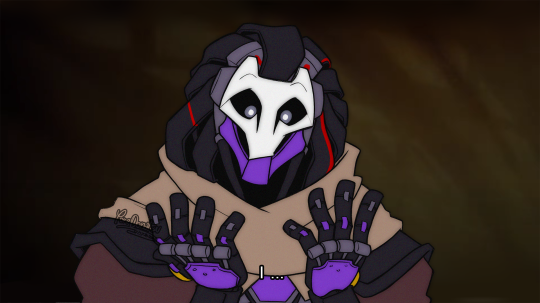
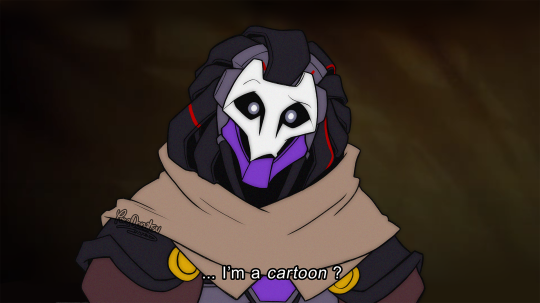
Little game: What film did I base these screenshots on ?
#overwatch#ramattra#The Husbanbot#fanart#screenshot#redraw#movie redraw#I had already asked with my previous redraw but nobody tried to find it ^^“”“#Hint: It's an old animated film from the '90s
344 notes
·
View notes
Text
GREEN NEW DEAL
Opening in theaters today:

Teenage Mutant Ninja Turtles: Mutant Mayhem--This new animated feature version of the adolescent DNA-altered martial-arts-practicing chelonians is about mayhem that arises due to mutants. In case the title doesn't make it clear.
The quartet, all named for some reason after Italian Old Masters, dwell in the sewers of New York under the strict protective care of their teacher and adoptive parent, the mutant rat Splinter (voiced by Jackie Chan), but long to go to high school, maybe have girlfriends. On one of their sorties into the city, they meet high schooler April O'Niel (Ayo Edebiri), who's an aspiring journalist. They also run afoul of an evil scientist (Maya Rudolph) as well as a gang of other mutant animals led by the monstrous Superfly (Ice Cube).
It's a striking movie to look at. The visuals have a garish, roughed-out, graffiti-esque look, and the animation has a stylized hint of stop-motion in the Rankin-Bass manner. Among the writers are Evan Goldberg and Seth Rogen; Rogen also provides the voice of the mutant warthog Bebop. The trailer and poster say the movie is "FROM PERMANENT TEENAGER SETH ROGEN."
The jabbery, overlapping dialogue is ticklingly funny, and I appreciated the characterization of the young April, who in the earlier movies has seemingly served as eye candy for the dads in the audience, as a smart and brave but unconfident kid with a typical body shape. As with earlier entries in the series, the film is packed with product placement, to the point that it becomes part of the comedy.
The Turtles made their debut in 1983, too late to be part of my childhood; my nephews were fans. I remember finding the '90s-era live-action TMNT movies annoying, but I found the live-action features of 2014 and 2016 surprisingly fun, even without a nostalgic attachment. Mutant Mayhem, however, may be the best-looking and funniest of them all.
As is so often the case in movies for kids, the ultimate goal that our heroes are seeking is, of course, acceptance, popularity, or simply "to be normal." This persistent theme can be tiresome, but undoubtedly it does reflect a common wish among this film's target audience. Permanent Teenager Rogen and his collaborators know their business.
#teenage mutant ninja turtles mutant mayhem#ayo edebiri#seth rogen#evan goldberg#jackie chan#maya rudolph#ice cube#paul rudd#hannibal buress#tmnt
7 notes
·
View notes
Note
So I read your thoughts on TLM II and I was just wondering if there was a princess or couple you’d like to see have a child/children - maybe not for a full feature length film but for maybe a 10 - 20 minute short film.
I’m very wishy-washy when it comes to children. Sometimes I love it when media gives a fictional couple I like children but sometimes it puts me off. Sometimes I’m split in the middle.
For example, I love the idea of Simba being a dad in TLK II and I really liked his character and how the movie showed how the PTSD from the childhood trauma Scar inflicted on him still affects him even though he appears to be this strong and powerful king and how even as an adult he still looks up to his dad. Unfortunately, whilst Kiara isn’t a bad character, I hated all of the next generation stuff. Like you said for TLK 2, it’s obvious that the sequel is much more cartoony and targeted for like seven and under compared to the wider demographic that the original film has. I can watch Lion King today and still love and enjoy every second. The same can’t be said for the sequel. Like how you came for Ariel and got too much Melody, I came to a movie called SIMBA’S pride and felt like he had to give up the spotlight to his daughter (and yes his personality was also reduced to ‘protect my daughter’).
This is an interesting question! I know they wanted to bring back the nine old men at one point in the late 90s and have them animate the princesses (up until Jasmine iirc) with children! I love the idea, but purely because I would've wanted to see Marc Davis return to Cinderella and Aurora, Glen Keane to Ariel, etc, but I don't really love the premise of any of them having children. Like I mentioned, I don't love having to divide the time we spend with a character with an OC. Most media doesn't do a good job of keeping the character intact after having a child either, it literally just becomes all about the kid and keeping the kid safe and who the original character was kind of gets lost and eroded in that entire thing, too. I also hate aged down content and "next generation" throughlines.
Out of the princesses I care about, I think Cinderella would be the most fitting to have children? Again, this is supposing the original creative team was involved (which is impossible since they've all passed on). But we've seen hints of what Cinderella would be like as a mother, through her relationship to the mice and I think she'd probably struggle with infertility due to how mistreated she was and neglected growing up, as well as the extreme manual labor she was forced to enact and how much of a toll that took on her body. Just like the dress enacted a plot device for Cinderella to connect with her mother, thinking of the type of parent she'd be during a pregnancy would probably recall so much of her own parents to her. It would also remind her of what not to do and of so many scars that her stepfamily inflicted. All of the things she had to repress to continue living with those monsters would then be brought back up to the surface. I think it'd also create engaging conversation with how the Prince was brought up and his own past and see where they agree and where they might conflict in ideologies pertaining to rearing a child. I don't think Aurora would have a child, since she's so defined by being a daughter to her parents and the three fairies. I don't know about Snow White- I'm sure she'd want them, but she's a perpetual girl in the best way possible to me. And, honestly, I think Ariel needs more time to discover who she is now that she isn't under Triton's repressive grasp so her having a kid would not be good lol of the princesses I don't care about as much, I don't know who I'd want to have a kid because a lot of the later Disney couples feel more like brother/sister to me than romantic (like Aladdin and Jasmine, for instance). I don't like Naveen, but I think Tiana having children would be really cute and would soften her up because the writers made her so career oriented in the film. I would love to see Mulan as a single mother teach her child the values of respecting your elders while also staying true to yourself and her validating her kid would be so cute. I don't trust literally any of the other later princesses to be moms though lol
9 notes
·
View notes
Text
0 notes
Text
Kaiju Week in Review (October 30-November 5, 2022)
This week actually brought more news than I was expecting... and I was expecting a lot!

Takashi Yamazaki will direct—or rather, has been directing—the next live-action Toho Godzilla film, which started shooting in March under the working title Blockbuster Monster Movie. (Gigant called it!) He also wrote the script and will supervise the visual effects, a level of control never before afforded a Godzilla director. Yamazaki previously directed the King of the Monsters in the cold open for Always: Sunset on Third Street 2 and the Godzilla the Ride: Giant Monsters Ultimate Battle attraction, but he's also been extremely prolific as a director of visually extravagant genre movies, including Returner, Space Battleship Yamato, the live-action Parasyte films, and Lupin III: The First.
Little is known about the story, save for the time period: early postwar Japan, specified in a casting call as 1945-47. That's rare territory for a Godzilla story. I believe Godzilla: Awakening is the only other example, and that was a globe-trotting adventure in which the Big G never set foot on Japanese soil. So it promises to be something truly fresh for his 69th anniversary. Nice.

The main attraction of Toho's Godzilla Fest livestream was the event's third tokusatsu short, Fest Godzilla 3: Gigan Attacks. These things get better every year; compared to Godzilla vs. Hedorah, Gigan Attacks had a bigger set, a new suit for the enemy monster and a much nicer-looking suit for Godzilla, sharper fight choreography, and more intricate VFX. If they keep getting longer too, maybe Toho will accidentally make another tokusatsu feature by the 2030s.
For the next few days, you can watch it on YouTube here (starts at 6:57:00 and is followed by a ton of behind-the-scenes footage). After the archived stream gets banished, find it on archive.org.

I kind of love when animation makes kaiju lighter and bouncier than they should be for the sake of slicker fight scenes, and the other Godzilla Fest short, Godzilla vs. Gigan Rex, certainly delivered on that front. And if you've always wanted Toho to revisit the Heisei continuity, there are a few hints that this Godzilla is Junior, including the long-overdue return of Megumi Odaka as the narrator. (As a Wikizilla bureaucrat, I am obligated to add that these are only hints, akin to the way IDW's Godzilla comics will sometimes allude to the films without officially being in continuity with them.) Assuming this is Junior, he certainly does his old man proud.

An onslaught of new Movie Monster Series figures were revealed this week: Godzilla '84, Gamera '96, two Shin Ultraman variants, Zarab's Ultraman disguise, and Mefilas. A site called Awesome Collector also opened preorders for Manda '04, Baragon '65, Ebirah '66, Hedorah '04, Godzilla '04, and King Ghidorah '91, due in February or March 2023. No images for them yet, but they foretold the MMS Salunga figure in the past. Finally, Showcase Daikaiju claims that the Godziban versions of Rodan and Anguirus will be shipping out next month. I'm more excited for those than the ones we got total confirmation of, to be honest. Though the Godzilla '84 looks more on-model than my NECA...
Oh yeah, there's an S.H.MonsterArts of the original Gigan on the way too. Not my thing, but nice to see them remember the Showa era exists.
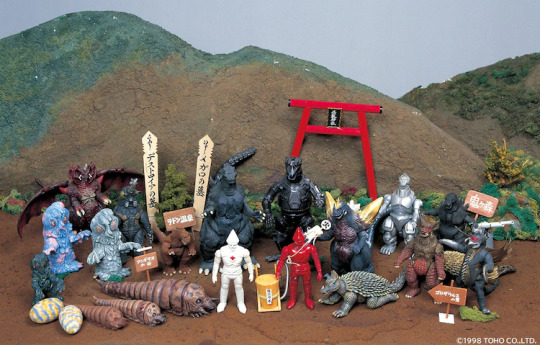
Buried in a Hollywood Reporter article about Blockbuster Monster Movie is the revelation that Godzilla Island will be coming to the English Godzilla YouTube channel (GODZILLA OFFICIAL by TOHO) later this month. Yes, the one from the late 90s where Bandai toys portray all the monsters. This will be its first official English translation; as someone who's watched the whole thing raw, I'm excited to finally learn what the hell's happening in some of those story arcs. The special effects are the least wild part of the show, truly.

Netflix released a full trailer for Troll which looks pretty spectacular; I did not realize the film had this much money to play with. Roar Uthaug (The Wave, the Tomb Raider remake) is the director. It's always nice to see another giant monster movie set in Europe—how many have there been since the glory days of Reptilicus, Konga, and Gorgo? Okay, maybe "Konga" and "glory days" don't belong anywhere near each other... the point stands.
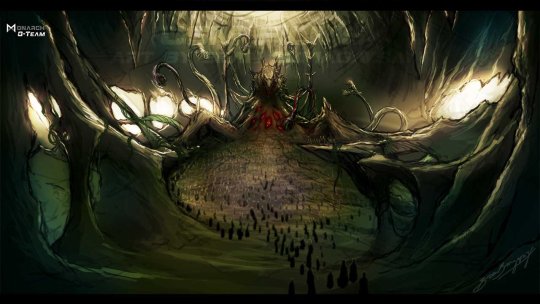
O'Shea Jackson Jr. has been writing the pilot script for a G-Team animated series with Toho Kingdom media relations director Chris Mirjahangir. (In case you forgot, that's Monarch's military branch, callously discarded in Godzilla vs. Kong like most of the world-building in King of the Monsters; Jackson played Barnes.) No story details yet, beyond plans to include Biollante and Gigan. Bear in mind this is far from a done deal; the strategy seems to be going public early to convince Toho and Legendary the demand is there.
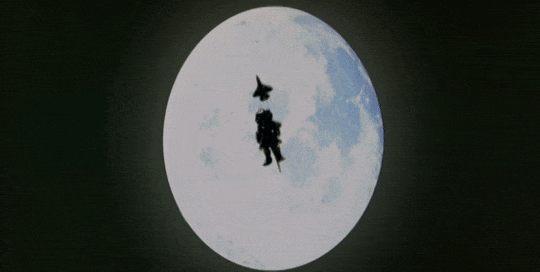
Fathom Events screenings of Godzilla Against Mechagodzilla grossed $335,000 from 727 theaters on Thursday, good for fifth place that day. Apart from the introduction by Chief Godzilla Officer Keiji Ota (who I hear was very wooden), Fathom included last year's Godzilla vs. Hedorah short and some behind-the-scenes footage of said short which I'm not sure has ever been released before. Thankfully, a couple people recorded that part.
The film itself had some frame rate issues, at least at certain theaters. The video quality also apparently dropped off whenever there were any English supers. The subtitles used the (superior) script from the old TriStar DVD, though a handful of typos suggested they were retyped. Still, people seemed thrilled at getting to catch a Toho Godzilla movie in theaters, and I can't blame them (G-Fest has spoiled me rotten).
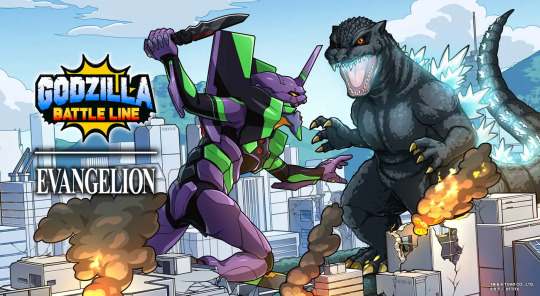
Evangelion Unit-01 has officially arrived in Godzilla Battle Line, with the Fourth Angel (called Sachiel in the original show) to follow mid-month. She's armed with a Gatling gun and a few neat abilities, like an AT field reducing the damage she takes while she's rushing and resistance to self-destructing units like Burning Godzilla and Zetton. Be forewarned that Shinji screams in agony whenever an Eva Leader loses a match. Battle Line also gave Kiryu an Evangelion skin—and the ability to evolve into the Modified version from Tokyo S.O.S. after being defeated twice in a match. Also, GigaBash released a teaser for their upcoming Godzilla DLC, and announced that three more Toho monsters would join the game as well. Be sure to feign surprise when they turn out to be King Ghidorah, Mechagodzilla, and Mothra.

I'll close with yet another plug for another kaiju obscurity brought to light by @spacehunter-m. This one's the 1958 German version of Godzilla Raids Again with English subtitles. It's a more straightforward dub than Gigantis; no banana oil, fire monsters, or unrelenting narration in this one. It also looks better than the HD transfer Toho has been trotting out for years, despite being in SD!
#kaiju week in review#godzilla#gigan#shin ultraman#gamera#ultraman#neon genesis evangelion#godzilla battle line#gigabash#godzilla vs. gigan rex#gigan rex#godzilla against mechagodzilla#kiryu#mechagodzilla#biollante#g team#troll#godzilla island#godzilla raids again#kaiju#tokusatsu#blockbuster monster movie#shin ultraman spoilers#video games
130 notes
·
View notes
Text
Animation Notes: The Human Head part 1: preliminaries
Hi friends! Remember Animation Notes? Sure been a while. Well, let’s see if we can bring that fucker back, since I would like to level up my art and that means, more studies.
To begin with, I want to look into the question of drawing the human head - one of the few body parts I can be absolutely certain every single reader has! So let’s get started...
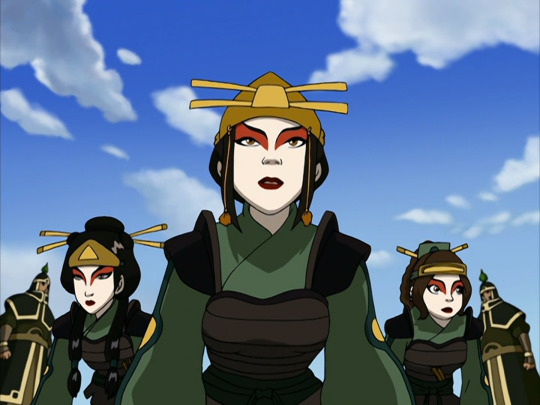
Here’s a still from Avatar: The Last Airbender, a Korean-animated show that in a sense functioned as a ‘sakuga awakening’ for me. In this shot, three villains have disguised themselves as members of a heroic faction called the Kyoshi Warriors who wear face paint and elaborate uniforms. Despite this, we can immediately tell all three characters apart from the familiar Kyoshi Warriors such as Suki, because the face models are just very subtly different.
This is the power level we need to be able to reach!
Human heads, and especially faces are really important. And as such, they’re really finicky. A minute difference in placement of a line can totally change the whole feeling of head. A particular illustrator’s way of drawing heads can act as a stylistic hallmark. For example, if I show you this picture...

I bet you could tell me at once that it’s by Moebius. Moebius was a very versatile artist who could draw a lot of different kinds of heads, but there are certain hallmarks here - the style of hatching with lines fading into dots, the fairly rounded circular shapes, and the shadow under the cheekbone. But mind you, here’s a crop of one of Moebius’s best-known pictures:
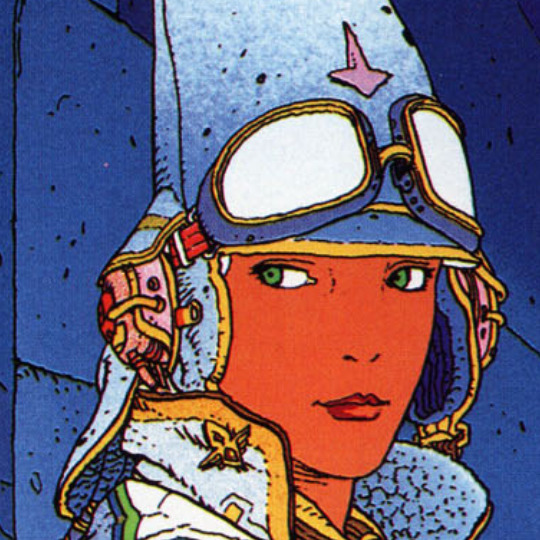
Here, he omits almost all shading on the face - just a little hatching under the chin - and avoids most lines altogether. Only the face contour and hints of line around the eyes, and the asymmetries in the eyes, lips and nose, tell you about the structure of the face. Despite this, the face feels unmistakably 3D.
At other times, particularly in his Western comics as ‘Gir’, Moebius would go for a really hyperdetailed style that’s just overloaded with hatching, as for example here on the cover of The Airtight Garage:

Here an enormous amount of detail in the face structure is shown: you can clearly see the major planes of the face, the wrinkles around the jaw, the shapes of the chin and nose and eyes. So you get the sense that this character is a sort of colonial masculine ideal like you might see in an old movie, a Lawrence of Arabia type of deal - an older authoritative man, who spends a lot of time outdoors. His expression feels thoughtful, perhaps a tad amused, but in a reserved way. All that from shapes and lines!
Moebius’s style might be considered a ‘realistic’ style, in that the proportions and anatomy closely correspond to what you might expect in photographic projection of a real person’s face, and he saves most of his stylisation for the rendering. (He wouldn’t always draw in this style, sometimes adopting a more schematic ligne claire style, but this is the one he’s most known for.)
In animation, it is rare to see this level of commitment to anatomical realism. But definitely not unheard of! The 90s anime ‘realist’ movement, documented in great detail by Matteo Watzky, had similar commitments. Per Watzky, a lot of the driving force behind what would become the ‘movie style’ in 90s anime, was prolific animation director Kazuchika Kise, who while working on the Patlabor films persuaded character designer Akemi Tokada to adopt a more realistic, less cute style compared to the original TV series - a perfect fit which became the standard in Oshii’s later films, particularly Ghost in the Shell.
Satoshi Kon is the other director who springs to mind on this front; I don’t have such clear info on the process for defining the look of Satoshi Kon’s films, but he was known for his meticulously detailed storyboards, and as early as Magnetic Rose you can see him working with the absolute best realist animators - notably distinct from the realism of Otomo, in terms of how subtly it handles its human characters. While Kon was not the primary character designer for all of his films - instead credits list Hisashi Eguchi (Perfect Blue), Masashi Ando (Paranoia Agent, Paprika), Kenichi Konishi (Tokyo Godfathers) - he is credited as a character designer on all of them and no doubt had a big influence on the style.
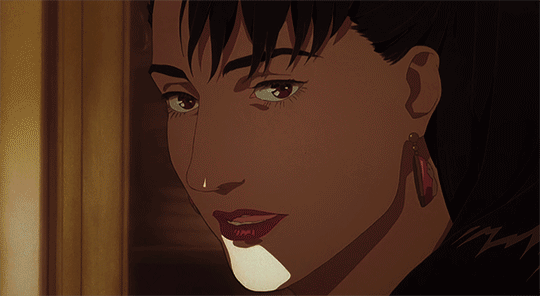
^ one of the many incredible shots from Magnetic Rose in the Memories anthology, where Kon is credited for writing and ‘setting’, but has been confirmed to have worked on layouts e.g. in this scene.
So ‘realism’ is one strand, and one of the most demanding. But this is not a post to talk about realism. If you want to learn to draw realistic heads there are many resources out there, and you’ll need to study photos as well. We’ll still talk about schemes for analysing the structure of a realistic head in a bit, since they’ll be relevant for the more abstract approaches.
But of course, the vast majority of the time, we’re actually abstracting away a lot of this anatomical precision for artistic effect. The prevailing style in American TV animation these days is to draw a head that’s basically two overlapping oval-like shapes, sort of like this:
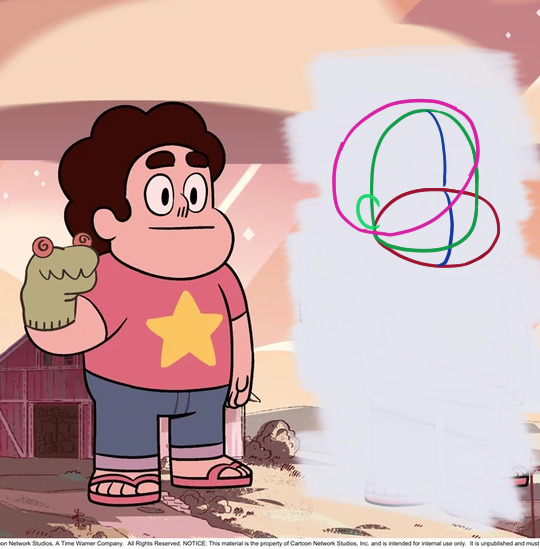
The connection to face anatomy may seem very distant at this point, and yet we certainly see this as a face, and the simplicity allows the animators to push expressions a lot more - and don’t get me wrong, drawing a simple but precise shape consistently is not a simple feat either. On the other hand, it is such an abstract 2D shape that it is rare to see such characters standing in anything other than a 3/4 view long shot facing the camera, which is a limit on shot composition.
We’ll cover a lot more examples soon, but let’s first of all cover some preliminaries!
The structure of a head
To draw anything from imagination, you have to have some kind of handle to simplify it. One of the most enduring approaches for drawing human heads is the ‘Loomis head’, defined by the widely influential American illustrator Andrew Loomis who wrote a series of widely referenced books on drawing up to his death in 1959.
In his books, Loomis mentions selling commissioned portraits to families, and drawing for advertising. Back in the first half of the 20th century, colour photography did not exist, nor tools like photoshop, so adverts were almost always painted by illustrators like Loomis. I’m sure you know the type. Here’s one that Loomis painted which I got off the Internet Archive:

Loomis-sensei painted thousands of illustrations across his life, all in what can be described as a relatively ‘photorealistic’ style - although bear in mind that any ‘realist’ drawing still very much involves abstraction and simplification. Given the prevailing social forces in his time, Loomis’s illustrations almost all depict a lot of quite similar smartly dressed white people, in a variety of settings; that’s what he’ll teach you to draw. But that doesn’t mean his insights aren’t useful!
So, the ‘Loomis head’. This is a particular schematic approach to breaking down the head into a few simple 3D forms, which Loomis recommends as the starting point of any head drawing - he advises you on how you can vary the shape of the head by squashing it around, but that the relative proportions tend to be pretty similar. Here’s how he introduces it in Drawing the Head and Hands (1956):
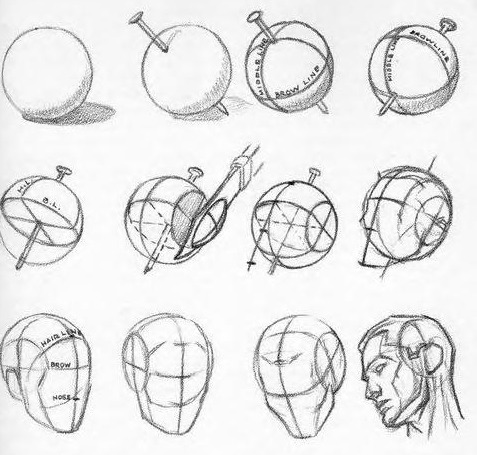
You start with a sphere with the sides cut off, and make sure to mark the centre lines and brow line; the point where they cross indicates the direction of your head in 3D space. So let’s do some studies.
Actually drawing a circle freehand is the most fiddly part lol. I noticed that in Loomis’s pictures, the flattened side almost always touches the outer contour of the sphere at a tangent. Anyway, here’s my go:
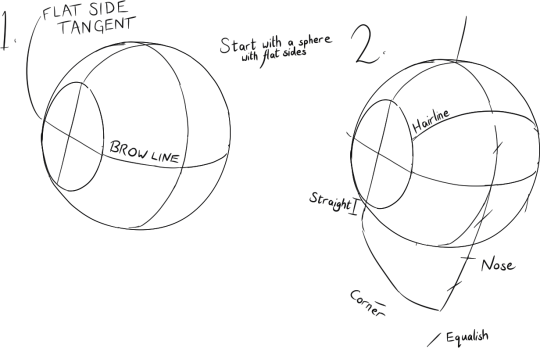
From this cross, you drop down a vertical line, about twice as far as the distance from the brow line to the forehead. The centre of this line is the bottom of the nose. To the bottom of this line, you draw a line in three sections connecting to the bottom of the flattened side of the sphere. These sections are the chin, the bottom edge of the jaw, and the vertical part of the jaw connecting to the ear.
Next, you draw the cheek contour, which is a boundary between two planes. This connects to the brow line, but notably there’s a bit of a kink in it, which I believe indicates the cheekbone:

You can then place your features to get your classic 50s advert guy. Though I drew it pretty rough, I tried to follow Loomis’s choices of what lines to draw and how to stylise, with this ref in particular:
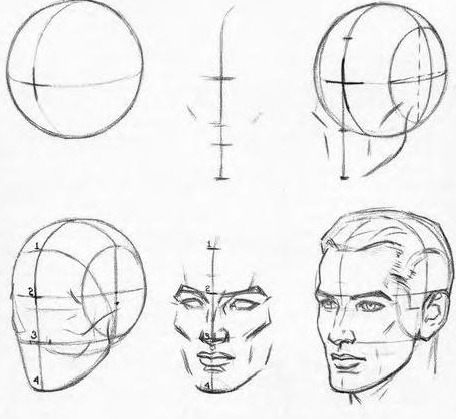
...though in my version the downwards tilt to the head and the slightly pouty lips make him feel like more like some kind of yaoi boy lol.
The cheek contour - more on that shortly - is made quite hollow, the more to emphasise the cheekbone itself. Inside the form of the face, Loomis seems to usually place a line indicating the transition from the front plane to the side plane of the head, again indicating the cheekbone.
The great advantage of this method is that by breaking down the head into simple 3D forms, you can easily place it at any angle (modulo your skill at perspective drawing!) within the picture. The features that Loomis emphasises are mostly, he writes, features of the skull; he offers a method for drawing skulls as well:
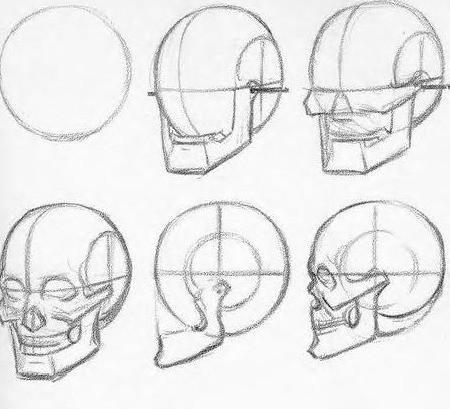
I tried to follow it with somewhat less aesthetic results:
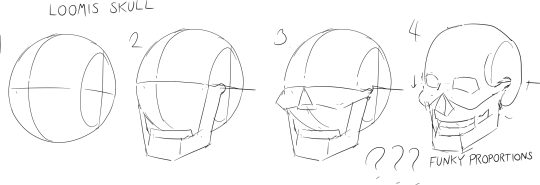
no doubt with practice i’d more reliably get the proportions right, but that would get us sidetracked.
From this basic construction, Loomis elaborates considerably, asking us to look at the planes of the face with increasing detail, resembling the Asaro head:

and offering advice on how faces might be varied from the basic template, on applying perspective etc. I will definitely come back and do more Loomis studies down the line, but we’ll leave it at that for now.
One other thing of note: after introducing men’s heads as the default, Loomis gives sections on womens’ and childrens’ heads. Gender divides are definitely emphasised in his work. In contrast to his male heads, Loomis advises you to eschew some of the planar structure he describes for men’s heads:
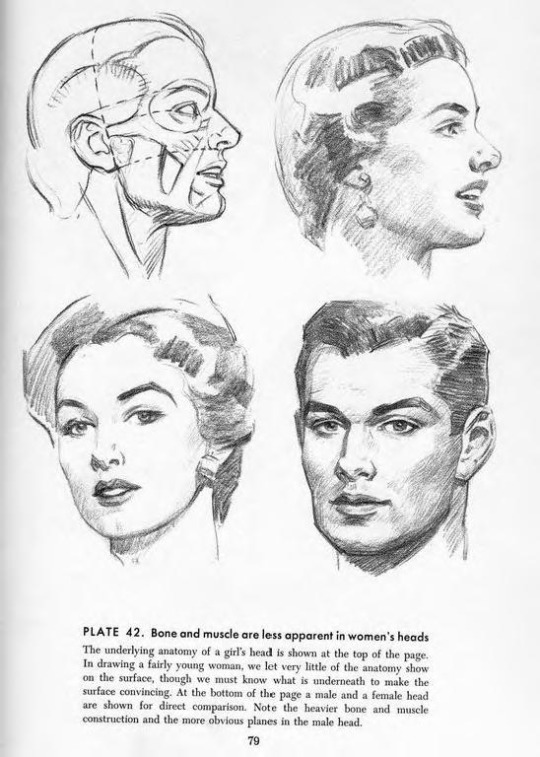
Nowadays the main reason to look at the Loomis head is not because you want to make a 1950s-style commercial illustration. Certainly, it’s useful for ‘realism’. But for our purposes, it’s also because a variant of this construction has ended up as the basis for a lot of standard designs used in anime.
For a more modern treatment of the Loomis technique, see Proko’s video:
youtube
In contrast to Loomis’s original method, Proko doesn’t have that small cheekbone kink in the line representing the plane change from the front to side plane of the face, nor the emphasis on the cross at the centre of the head as the starting point of the drawing. So don’t assume when someone says a ‘Loomis head’ they’re exactly going to use the method outlined above.
Other ways of breaking down the head
Loomis may have one of the simplest and most straightforward methods, but I would be remiss not to mention other important breakdowns.
The ‘Asaro head’ is a small plastic statue made in the 70s by John Asaro, widely used by painters as a way to break down the planes of the head for light and shadow. Here’s a render of a 3D scan of it:
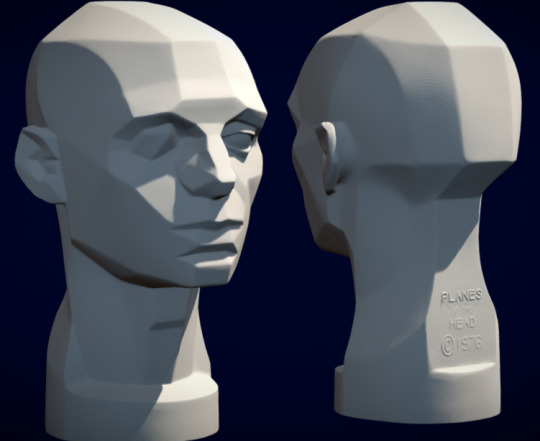
With the Asaro head, we can really clearly see how the front planes of the face form a kind of inverted triangle, narrowing towards the chin, while the back of the jaw is of course much wider. While it’s useful to be aware of these plane changes, they’re mostly relevant at a later stage of the drawing, when we’re dealing with value - although we may choose to mark the plane changes with a line.
Then there’s the Reilly method, which is broadly less popular than the Loomis method, breaking down the head not into blocky 3D forms but a series of arcs and proportional measurements designed to find relationships between features of the face. This is named for another early-20th-century American illustrator and art teacher, Frank J. Reilly, who lived from 1906 to 1967. Here’s a video that breaks it down step by step:
youtube
Honestly, I’ve never tried using this method, it looks too cumbersome to be very useful most of the time. But I do feel like it might be useful to apply it at least a few times, to try to get an intuition for the information it gives about planes and structures.
The jaw/cheek contour
All well and good for painters, but let’s assume you are in a flat- [kagenashi] or cel-shaded style; then what does give your drawing structure?
I’ve increasingly been inclined to see the contour of the face as being one of the most important parts of the drawing: the lumps and bumps there carry a lot of information. And this is also the path we’ll be taking towards more stylised heads.
Let’s start with realism, though. I took a photo of myself at a 3/4 view and traced the major plane changes and structures:
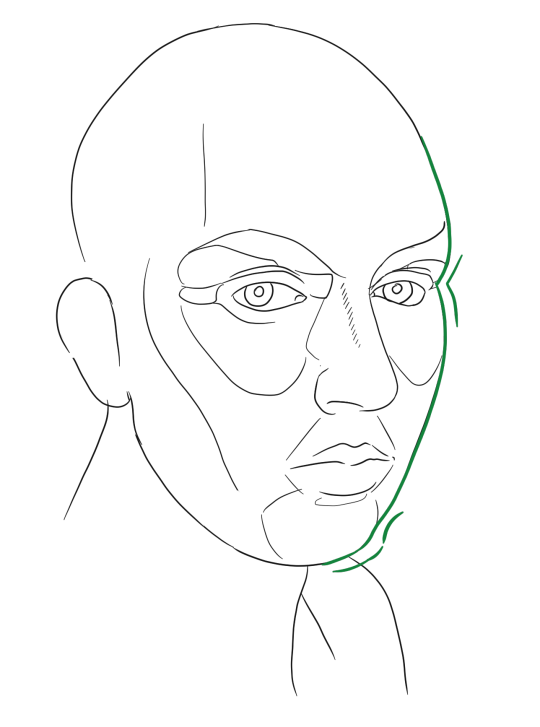
That’s one uncanny looking picture, but let’s now take a look at the green line on its own:

I marked two important points. The first one is the indentation of the eye socket. Depending on angle and size of the eye, this may be less sharp.
The second is the chin bump. We can think of the chin and ‘muzzle’ of the mouth are smaller forms which poke out of the overall simple ‘Loomis head’ wedge shaped structure.
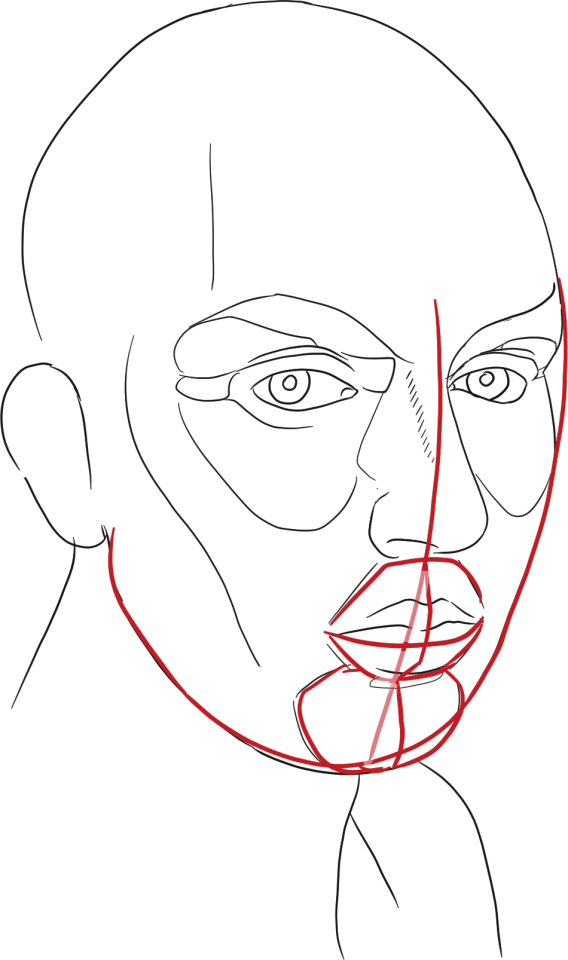
In the case of plumper cheeks, we can imagine a kind of ‘cheek bump’ as well, which has the effect of making a character look younger.
If we view the head at a more oblique angle, closer to a profile view, the bumps become more pronounced: the lips start to cross that contour line and the cheekbone becomes more evident. This time I’ve tried to indicate major plane changes with cross-contour hatching rather than lines, imitating Moebius a little.

Note that even though the lips don’t outright cross the contour line, the ‘muzzle’ does create a break in that contour line there.

Of course, there’s a lot more to it than that. The size and shape of the main features are also incredibly important, as is the approach taken to light and shadow. But when we start breaking down particular artists, particularly in anime, this concept of a contour line will be valuable I think - I certainly think about it a lot when drawing.
Next time: A survey of the diversity that exists within ‘anime style’, and an account of its stylistic evolution!
43 notes
·
View notes
Text
Inspired by @madamescarlette doing a hint list for the movies.
1. Early 2000s romcom
2. Ferris Beuller
3. Princess Bride
4. Historical war drama w Christian themes
5. Gorgeous 2D old disney
6. I am not immune to animated little boy movies (worlds awesomest redemption arc)
7. LOTR
8. DCOM
9. 80s, summertime
10. Pixar, dry humor, wildly quotable
11. Animated mocumentary, killer soundtrack
12. Much Ado About Nothing (Branagh)
13. Brat Pack
14. LONG period piece
15. Goofy cult classic, popular w film bros
16. Homey period piece, 2 VHS tapes, mecore
17. Animated, cozy, seaside
18. Robin Hood (1939)
19. Movie from a 90s TV show
20. Technically the 1st season of a webseries but it was on netflix as a movie so I'm counting it
4 notes
·
View notes
Text
Fruits Basket Manga Review ch (90)- First pages ONLY.
I skimmed thro ch-89 to know the context of ch-90. it was Cinderella’s play. In this chapter, Kyo says early on, that time has passed since the play & that they are NOW starting their third year in high school. cool.
This part will ONLY focus on the 1st few pages of ch 90 abt (kyo & tohru) & stop before kyo’s memories starts, because the early pages contain:
Tons of new unexplored analysis of (kyo & tohru) characters that unfortunately was intentionally cut & worse! “changed” in the anime.
No space to add kyoko’s story in this post.
Kyoko’s story is full psychologically & socially.. I need to take a deeeeeeep breath before I unpack it. very deeeeep breath!
-Glimpses of Tohru (the silent grieving girl) Subtle Writing of Grief:

Right from the beginning, I hate how much insight into tohru’s grief & weakness as a human being is already there in the first few pages of ch-90 than the entire 3 seasons of the anime! From few pages we have:
Tohru’s seemingly delighted watching a video. Subtly, showcasing tohru’s grieve & paving the path for tohru’s trauma exploration later in the story. Grief is not sth you quickly past, that’s the most tragic misunderstanding of grief. Time will pass, so, you’ll be better & healthier. Really?!. Tohru’s inner desire to see her mom alive manifested in her words: “ like a photo comes to life” T_T.
The story/writing/manga is acknowledging tohru’s heartbreaking & NOT cute habit of talking to her mom’s cold dead photo! In the anime, tohru talks to her a lot in se01 & it’s up to you to see as as “ cute” as all the canon characters do or actually feeling it IS wrong. Kyo’s “ what would she do if there were a video of her mom”! “ drives the point more abt tohru being a sad grieving human~not the “advice-giving, optimistic angel, & rain-stopping sunshine in the anime.
Tohru telling kyo to NOT catch cold connecting it to se01, ep 9 (haru’s ep) when tohru was afraid that yuki might catch cold & kyo noticed that! so now in se03, they’re dropping this plot altogether within the main anime, for what? we dont even know if this part would be included in whatever “ kyoko’s” spinoff content would be. -_-’.
That’s how you write subtle trauma such as (grief) for a main (female) MC. subtlety is the key. Respect the viewers intelligence & do it.
You don’t have to give her the long speeches or the many focused ep that yuki had. he’s the kind who confront himself inwardly constantly.
You don’t have to showcase drama, confrontation & force the emotions out like you did with kyo. he runs from his trauma & punishes himself.
Tohru buries her feelings! she’s different from both kyo & yuki. So, with her subtle & symbolic scenes are enough!!!The viewers will catch it if you show it, but ignoring it, cutting it & hoping the viewers will magically predict what you cut, is weird. But the anime isn’t even into us predicting nor subtly showing her cuz this tohru is NOT the tohru we have in the anime. How?
Simply cuz there is no kyo’s inner thoughts abt small things such as tohru’s photo obsession which subtly shows her grief & trauma. If kyo didn’t monologue abt her, tohru does not exist as she’s meant to be. You loose the subtle insights into tohru if you cut kyo’s inner thoughts. Not everything kyo thinks abt in regards to tohru is romance!!! That’s a very narrow & superficial look into the writing of kyo/’tohru dynamics. Flip the pages, hmm..cut this kyoru scene here & there cuz we dont want the anime to be only their love story.. But the story itself IS NOT only their love story at all. These pages/scenes here are abt tohru as a PERSON. Not tohru the lover...
- Writing Clashes between manga & anime: (Kyo’s Conscious Gradual Psychological Exploration vs Shock Value & Drama)

In ch 90 i really love all the inner self talking that kyo’s doing. It really explains why he ended up rejecting tohru so strongly. Also, going for a trip into kyo’s mind is hella exciting, new, refreshing & full of analysis-worthy exploration! Kyo’s inner psychological argument with himself is a psychologically-informed presentation of a tried guilty mind:
“ Why can’t I stop thinking of (kyoko’s words) lately? Acknowledging that he IS remembering kyoko & never forgot her. This is also supported in the anime itself. When he apologized to a sleeping tohru in se01, ep14 & se02, ep9 , confronting yuki in the stairs & other instances as well.
“ It’s like a lid been opened & all the memories came pouring”. Acknowledging that kyo DID open his lid since se02, ep9 byt chose to run & not confront it due to his guilt of ruining tohru’s happiness by confessing his connection to her mom.
“ pretending I didn’t know, pretending I forgot”. Here is a blatant clash in kyo’s writing (1) between the anime & manga (2) between the anime’s episodes themselves!!. In the manga, again kyo chose to ignore & pretended to forget. Death is NOT sth you forgot. Kyo saw kyoko bleeding & dying. The anime chose to make him totally forget & it could’ve worked if they didn’t included all the canon moments of him actually remembering & pretending to forget. Is that lazy writing? or was the director for se03 different from se 1 &2 &? chose to NOT watch the two previous seasons? Why would you consciously include a contradicting depiction of your character on screen for thousands of confused viewers? Was the scene of kyo’s shocked gave upon seeing kyoko’s photo that artistically appealing that you forgot everything? I really have NO problem of kyo forgetting kyoko if that was written in the anime since se01, but it wasn't. that's why it sucks.
“Is this payback? maybe I want to blame ME?” augh! i love this line so much! Directly hinting to the viewers that this is kyo’s one-sided guilt before his story with kyoko even started! subtly paving the path for the reason of his rejection of tohru” I dont want forgiveness. I want to blame ME.
-I don’t mind that the anime left kyo’s thoughts of kyoko until the climax in eo8, cuz ep 8 was SO well-done! Se03, ep 8 pacing was very suitable to (1) uncovering dark secrets & death, trauma, & guilt. (2) for exploring the effects such secrets on kyo’s character, decisions, mentality. Also, the animation of kyo’s face all ep 8 was one of the most expressive facial expressions the anime has ever delivered! The eyebrows, eyes, mouth, tears, body languages, heartache was all 100% perfect. The fact that the following eps didnt have much time to express everything & chapters were cramped is not ep 8′s fault but the decision to have 13 eps. Kyo’s delayed trauma deserved to have its own ep.
-What I DO mind is the added scene of ep 6 where he freaked out upon seeing kyoko’s picture, the concept of shock is perfect & so suitable for an anime but was NEVER properly written into the anime itself from the beginning. On the contrary, the anime itself contradict such usage of such value. Good job ruining an otherwise perfect-depiction of two traumatized characters (kyo & tohru) with ONE scene.. -_-
Side Notes:
I thought tohru is narrating the 1st page in ch-90, turned it out it is kyo!!!! Kyo narrates sth? Kyo monologues? kyo has a POV? Just the setting of kyo doing that feels different! I duno if it cuz when that happens in the anime it’s always clash & drama! lol, or cuz it’s sth original!
Shigure’s “ it’s broadcasted all over the nation” is epic! XD! you know poor stupid kyo would fall for that! XD. kyo, you really are an idiot! XD... man this scene would’ve been epic comedy~ lol.
Tohru not knowing what a “dvd” is is outdated for the anime, but to still keep the sentiment of “her wishing she’d have a video footage of her mom”, they could’ve replaced her words with “ It’d be fun watching this play years from now & remembering all the details”. I know that to some, it feels weird that tohru doesn't have video footage of her mom in this era. but trust me, this is more common than you might think. My late brother, who’s way younger than me, doesn't have much video footage, he always felt awkward & preferred not to be filmed. We got photos for him tho~
Even if you want kyo’s knowledge of kyoko to be in the climax only. You can always include this scene of tohru & kyo in the first pages in the anime somehow. It doesn't even need to be abt the dvd even tho that’s manageable. Cutting this short scene of them talking abt videos, & catching cold is cutting tohru’s trauma from its core. Then, the old grandpa’s narration from se03, ep6 would at least have some backup in the anime’s canon.
Momiji & shigure are perfect as a comedic duo!
I can’t get over tohru’s art~ <3
Pinning kyo at the beginning is epic~ kyo always gets the BEST romantic lines when he talks to himself. “ burning (tohru’s ) memories into my head or forgetting everything”. The torturing fire inside him is only distinguished by loving her but is also ignited by loving her~ what’s the solution~

#Fruits Basket#manga#fruits basket manga#manga spoilers#reading paper#love the new content!#Hate the missing content#lol
63 notes
·
View notes
Text
Sailor Moon Eternal part 2 review
This review will contain some spoilers.
So the dream arc is my favorite story arc of sailor moon. I even adore the supers adaptation of it. The second movie does an excellent job of adapting the remainder of the dream arc. It has beautiful animation and character designs, a beautiful soundtrack with some nostalgia thrown in and a fantastic story. The second movie is where the plot really starts moving forward.
So the dream arc offers some backstory and world building, highlights the individual guardians, with this second movie focusing on the outer guardians as well as some development for both mamoru and Usagi. Get prepared to learn more about the silver millennium, Mamo and the Golden Crystal. The Golden Crystal's role is quite different from the 90's anime and far more interesting. People have complained about mamo being useless for far too long. It's about time he gains the ability to truly stand with his love. It's too bad it took so long, we won't be seeing much of it in this movie or hereafter.
Now Nehelenia is a petty woman and I adore her and her circus. The Amazoness Quartetbis such a fun group and I'm thrilled to finally see them in all their guardian glory. The old anime redeemed them as well but made the bad choice to not reveal that they are sailor Guardians destined to fight with Chibiusa. It instead chose to lightly hint that they'll meet again and then never show it. Unlike in the supers arc adaptation, Nehelenia is completely defeated here and won't be an opponent in the stars arc. She also has no tragic backstory bit is instead quite similar to Maleficent, the wicked fairy, from Sleeping Beauty. While she doesn't have a tragic story this time around, she does offer an interesting perspective when paired with Queen Serenty.
Alas, for all this movie does right, it's tight run time hinders it. The film goes by at a rapid pace. You'll want to give it your full attention so you don't miss anything. Sadly the movie, much like crystal cuts some fun moments, as well as some backstory and explanatory content. If your left slightly confused by anything, I encourage you to give the manga a read to fill in the blanks. My honest oppinion though is that you'll comprehend everything fine.
For example, I believe in the manga the guardians visit their castles or at the very least we get a view of them. Each one has a fantastic design and we're a gift from Queen Serenity upon the birth of each guardian. The anime cuts the backstory and were just sort of told they have castles and need to channel their power to help sailor moon.
For those of you wondering, yes saturn has a transformation at last. And it is completely underwhelming. It's animated beautifully, there's just not really much to it. They could of kept it relatively the same but with a little more oomph. Like have her state on the crystal rocks around her or something. We waited years for this and will only see it once.
Helios and chibiusa are portrayed excellently here. Their romance is truly a highlight and a personal favorite of mine. The resolution to their character arcs is far stronger here and it it climaxes with a moment that heralds back to the iconic Usagi and Mamo moment in arc 1 where the silver crystal reveals itself and saves him. Only this is Chibiusa's moment to shine.
Now the soundtrack, anyone feeling nostalgic should definitly watch the credits. While the first film used the first ending of super s the second film used the second and it's just as fantastic as you'd think. It will make you want to dance like the guardians did in the old ed visual.. The other song played during the credits is another character song that can be found on the soundtrack. Please give it a listen.
Well that's it for now. The movies were fantastic despite their faults. Let's hope we see the stars arc soon. I'd be happy for wither a few more movies or a season. As long as it comes fast.
"Inside each of us is a star"
9.5/10
-.5 for cutting castle content. I wanted to see the castles lol
#sailor moon eternal#sailor moon crystal#sailor moon#sailor moon helios#sailor chibi moon#chibiusa#chibiusa x helios#pretty guardian sailor moon#pretty soldier sailor moon#sailor neptune#sailor uranus#sailor pluto#sailor saturn#usagi tsukino#mamoru chiba#amazoness quartet#sailor quartet#queen nehelenia#setsuna meioh#michiru kaioh#hotaru tomoe#haruka tenoh#sailor mercury#sailor mars#sailor jupiter#sailor venus#sailor mini moon
32 notes
·
View notes
Text
Tex Avery Birthday Spectacular!
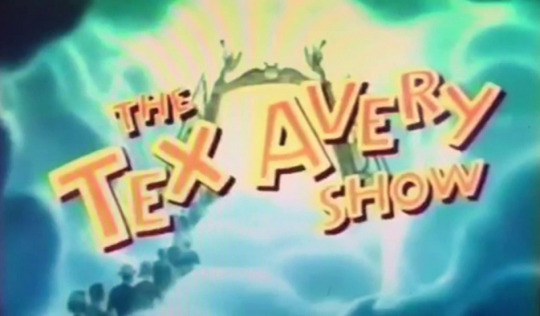
Hello all you happy people! And welcome to a celebration of the only cartoon director I knew as a kid and one of the finest whose ever lived, Mr. Tex Avery.
Avery is a legend in the animation industry and rightly so. Starting out at a few other studios, and loosing sight in one of his eyes due to some tomfoolery at one, Tex was annoyed with the restrctive enviorment and eventually found his way to Termite Terrace, the animated shorts wing of Leon Schislenger Productions, aka the future Warner Brothers Studios and the makers of Looney Tunes. And his impact on the franchise is vast, cannot be overstated and I only learned about just how much recently: The man created Daffy Duck and Bugs Bunny, created the prototype for Elmer Fudd, and created the design for Porky we’re all far more familiar with.
Eventually though while he was happy there, his career when ended when he eventually got into a squabble with Leon schsinger over the ending of “The Heckling Hare” and left soon after. Given he got a four week unpaid suspension for it , a bit extreme given all he’d given the studio, I can’t blame him. He instead went over to MGM who badly needed his wacky energy, and thus got to go as nuts as he wanted, with creative control a better budget and the result was his peak and classic characters like Red and my personal faviorite and personal boy: Droopy. I will try and do a birthday thing for him next month, we’ll see if my rather packed schedule will allow for it. Point is I watched the guys cartoons a lot as a kid between looney tunes and his shorts being repacked for the Tex Avery show in the late 90′s, and until recently I had no idea the depth and scope of his career: The guy gave looney tunes it’s standard fourth walll breaking and made it a huge part of the industry, and he was the one to hlep htem break out of being a Disney knockoff and into what we know today. The guy has my utmost respect so today I honor him as the first animator to get one of my birthday specials: As is my standard ten shorts, my patreons get to pick one each (I now have two but she start’s next month so her benefits will too) if they so choose (Kev opted out of the porky pig one next week) and I went to my friend blah for a recomendation as he’s an avid fan of the golden age of animation and thus usually has a really good choice up his sleeve. Now that’s out of hte way join me under the cut for some shenanigans as old tex would want it that way.
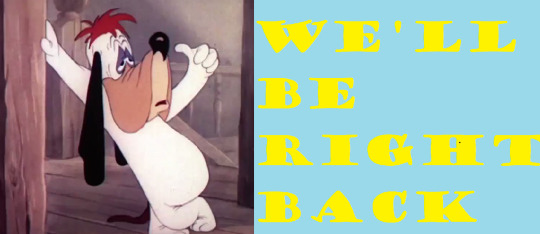
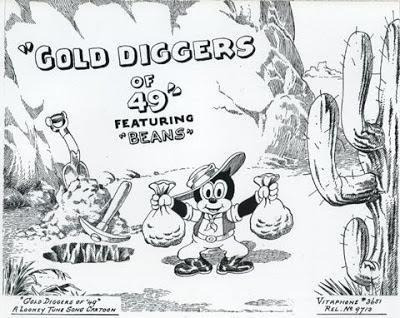
1. The Gold Diggers of 49 (1935)
This was Tex Avery’s first short with warner and the first of his I could find, not ot mention his first time working with Chuck Jones and Bob Clampett, who he’d mentor and go on to be the heart and soul of Looney Tunes and define the characters Tex created. And since this is more significant than his earlier work i’m coutning it as his first. And as a start it’s.. ehhhhhhh.
I don’t blame him for it though. Most don’t hit it out of hte park their first time up to bat, and frankly the deck was stacked against him. He was saddled with Beans the Cat...
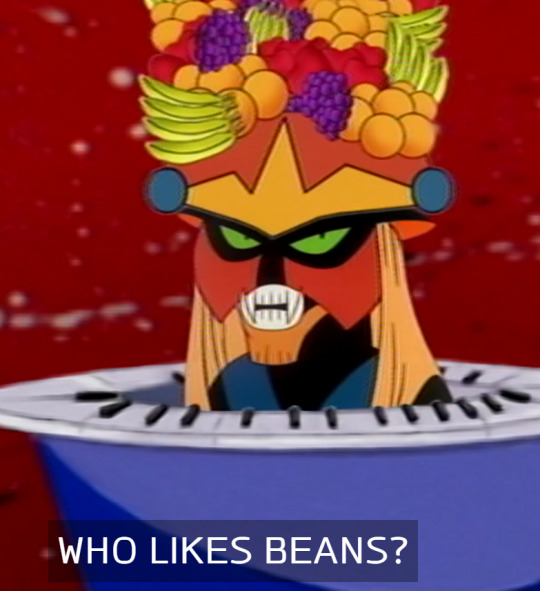
No one brak no one. He was part of an attempt by warner to create a new star as part of a Little Rascals/Our Gang style group of kids debuting in the short “I Haven’t Got a Hat”. This short is notable not for Beans, who no one cares about, but for the debut of Looney Tunes first star: Porky Pig. Porky was just one of the various characters but the only one audiences really liked. It took some time for Warner to get the hint though, hence Beans starring here and Porky playing his girlfriend’s father.. and also now being much older than him for some reason.
So instead of being a Little Rascals ripoff bean is now a mickey mouse ripoff, as the short gives me mickey mouse vibes.. but without the things that made those shorts actually good and feels mostly built on studios trying to make what they think audiences will like. There’s sparks of waht Tex would become.. but just not enough wiggle room for him to make something special. Also porky looks and sounds weird in this one and Bean’s girlfriend has a REALLY annoying voice. Oh and two horrible Asian stereotypes, because it was acceptable at the time but lord was it never okay. Then again I should be at least mildly greatful none of the shorts had blackface.. because tex apparently REALLY had a problem with that, something I obviously didn’t know as a kid as they edited it out but given most of his MGM shorts have “blackface edited out of x version”, yeahhh.... I may like the guy, quite a bit and feel those gags weren’t done out of malice.. but it dosen’t make them okay, they were never okay and he should’ve done better.

2. I Love to Singa (1936) Thankfully our next entry is 800% better, as we get a classic from my childhood and probably multiple childhoods. Admittedly part of the reason this one stuck in my head is the title song, sung by a young jazz singing owl whose dad doesn’t like that he sings Jazz instead of classical, enters a contest and nearly looses singing classical to please his dad only for his dad to intervene and finally accept his son. It’s a wonderful story of acceptance with some decent gags, beautiful animation and one hell of a title track that will probably never leave my head. The song is really what makes this short and sometimes that’s okay. Also just to note so someone else doesn’t: This short was a parody of the Jazz Singer one of the first talkie’s.. and also a film that uses blackface and whose 80′s remake bafflingly also uses blackface for some reason. Yes really.
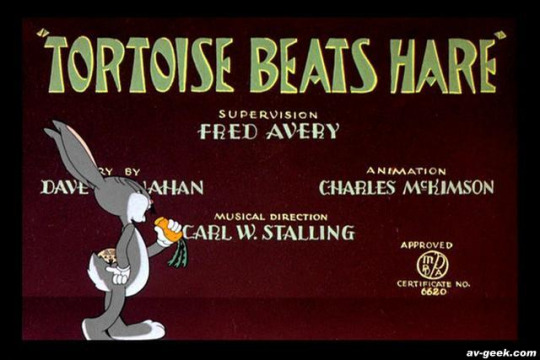
3. Tortoise Beats Hare (1941)
One of Tex’s only four Bugs Shorts.. but given 3/4 of them are certified classics, and one of them involving a horrible stereotype.. to the point it’s part of the rightfully infamous “Censored 11″ and the ONLY one involving Bugs Bunny.
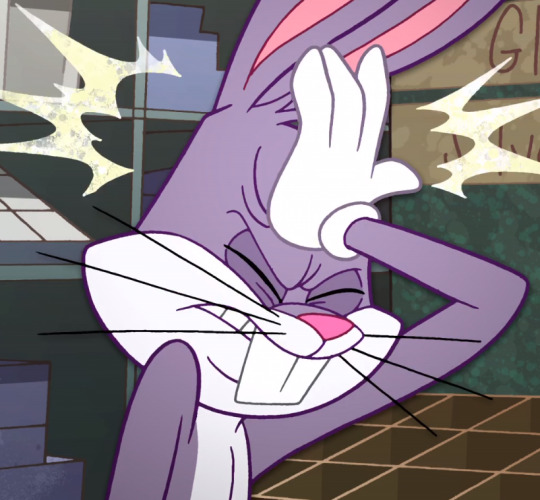
So as I said, Tex has a bad history with casual racism, and while it was the style at the time and I don’t THINK he was actively malicious towards black people.. it doesn’t make some of his work any less harmful. The rest of his bugs work though is remembered for the right reasons: his first appearance, and early classic we’ll get to next.. and this standout everyone who saw it as a kid or an adult fondly remembers.
You all know the premise: Bugs finds out, in an utterly brilliant wall shattering bit at the start where he reads off the crew names and then the title, that this picture will have him beaten by a turtle and taking offense to that challenges the guy. This is honestly one of the few Bugs shorts where he’s the out and out villain of the picture. He’s doing this race purely out of ego, yells at Cecil whose perfectly nice in this one, and in general is the bully set up for a fall he’d later be famous for taking on. But it works, both because this si early in bugs career so it’s entirely in character, and because Mel just really sells the obnoxiousness while still being funny.
This short also has one of Tex’s trademark setups as this is essentially a prototypical droopy cartoon: A meek, goofy voiced protagonist whose shorter than his large obnoxious enemy and who torments him by showing up every where he’s going to be and casually doing it. Cecil even does so using an army of fellow turtles with Droopy later using a similar trick in one of his shorts. As a big Droopy fan i’m clearly not complaining and while Droopy would do it better, this short’s still a classic for a reason with tons of great bits and is a fun break from the usual bugs setup, though in full fairness the usual bugs setup is still solid gold so take that how you will.

4. The Heckling Hare (1941)
Originally I was going to have Daffy in Hollywood in this spot as I thought it was on Max, it was not, so I swapped it out with his final bugs cartoon. For the record his first, and Bugs, is being saved for Bugs birthday this summer. And honestly i’m glad I did because this was 7 mintues of pure joy that has another setup that Tex himself and other Looney Tunes animators would resuuse: Bugs being pitted up against a far dumber antagonist. One who often still fully deserves it but allows him to just have fun for several minutes at this dumb bastard’s expense. It works well here, with tons of clever gags, my faviorite being the two doing dumb faces with each other only for bugs to stop and pull out a sign as seen right above.
It’s also an approriate capper to our warner made Tex shorts for the day, as this would be the one that got him fired. He and Schisnger argued over it and he got suspended as I mentioned and I found it again a bit fucking extreme. So did Tex and after a handful of shorts elsewhere, he’d move over to MGM, whose cartoons would ironically be bought up by warner. They needed a shot in the arm to compete with Disney and Warner and Tex was happy to provide hte needle filled with nonsense. And the results.. are pure gold.

5. Dumb Hounded (1943)
I’ll admit as a kid I didn’t know Tex’s MGM shorts were theatrical, or any shorts but somehow I knew they weren’t looney tunes. Besidds obviously having hteir own show they just had their own tone and pacing and style. While the Looney Tunes aren’t bad, at all honestly, Tex’s work here was in a class by itself with MGM gladly giving him a higher budget and even more creative freedom. And the results speak for themselves and one of those results is one of if not my faviorite classic cartoon character. And since I might not be able to get to his birthday with one of these next month, though i’m certainly going to try march is just VERY VERY FULL. Anyways point is our happy hero was introduced here. And given i’m frequently depressed and often withdrawn, not that you could tell from my reviews here, I related to this depressed bulldog who always won anyway despite being an outsider, finding love, sucess and always beating a much larger, much more assholish antagonist. But Droopy is good on his own merits as his shorts are just that funny.
This was true from Day One as dumb hounded is fucking perfect: The Wolf that Avery always used in his cartoons escapes from jail and is hunted by bloodhounds including our boy, who charmingly introduces himself with “You know what, i’m the hero”. From there it’s a simple setup but a great one as Droopy finds the guy.. then chases him from here to enternity with one amazing gag after another. Simple, utterly hilarious and the dawn of a legend, with the ending having Droopy go a bit nuts after getting his reward money before returning to his usual demeanor “You know what? I’m happy” So am I bud, so am I.
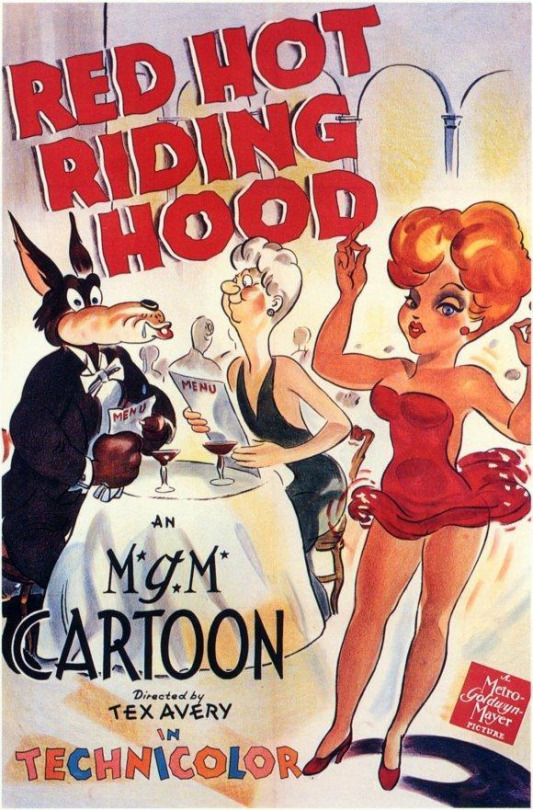
6. Red Hot Riding Hood (1943)
Yup same year. Tex hit the ground sprinting. This one is his signature MGM toon and for good reason. Using his usual forth wall breaking style, both the wolf and red riding hood rebel when it opens with a typical telling, so it changes to a 40′s nightlife setting: Grandma lives in a penthouse and is man hungry, Red is a fanservicey night club act and the Wolf is a sexually harassing asshole who chases after here and has some over the top reactions to her that are iconic in some’s mind.
The short is gorgeously animated with Red’s dance sequence and Wolfie’s reactions being the highlight and the short isn’t as bad as it could be as the wolf is treated as a scumbag for hitting on her and generally being a creep. SO the first two thirds aren’t bad with nice touches like the narrator clearly improvising the new story. It’s just badly hampered by the last half where Grandma sexually harasses Wolfie and it just doesn’t work. This double standard stuff annoys me and “haha get it it’s funny when a woman stalks a man” isn’t funny. Wolfie stalking her really isn’t that funny either it’s just not you know an entire third of the film. So a classic for a reason.. but one that really has degraded with time. Still worth analyzing and what not, just not great.
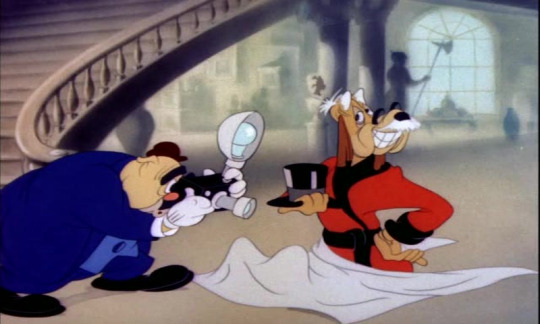
7. Who Killed Who? (1943)
Yes still. It was a good year. This is another one off like Red Hot Riding Hood and as is tradition since the Tom and Jerry one, my patreons each get to pick one and Kev selected this one. And this.. was a great choice.
Seriously I could not stop laughing with a great gag a minute, WAY too many to mention, a classic ending, and just nothing but net the whole time. I don’t have much to say really.. but because this one’s just good. The whodunnit genre hasn’t really gone away, it’s cliches are welll known even today and this is a lovely parody of it that hits the ground running after a live action intro and runs right through the wall across a lake and straight into droopy “You moved.”.
The only real observation I have other than “This is fucking awesome watch it immediately” is that the villian looks exactly like the Phantom Blot. Who knew the Phantom Blot was a live action guy with a weird haircut the whole time huh? Seriously this one is a masterpiece, an instant faviorite, and I highly recommend it.
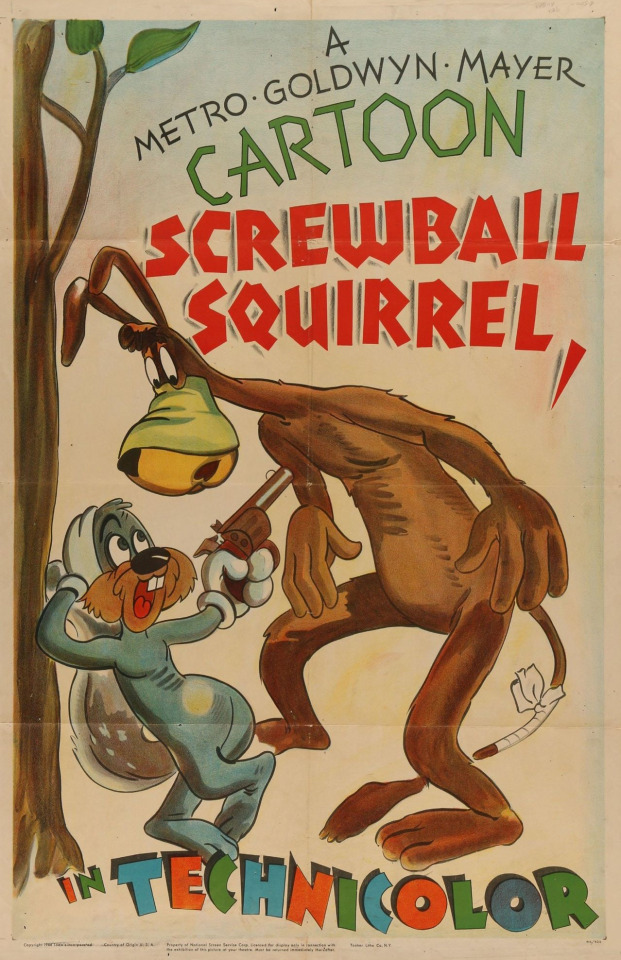
8. Screwball Squirrel (1944)
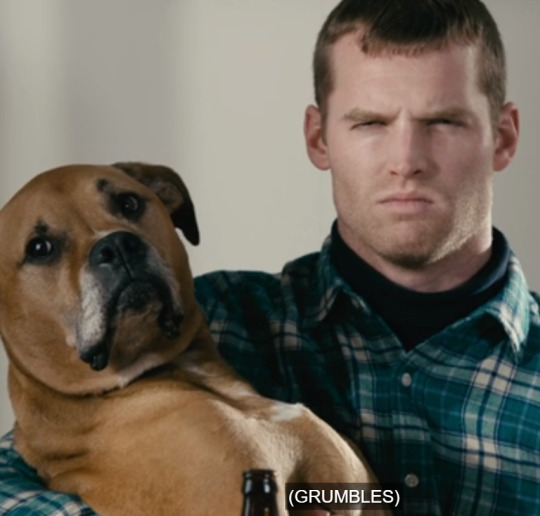
As you can probably guess by how I lead it in this one is not very good. It is tex TRYING to make a bugs or daffy type character again and somehow failing at it. He created them, he did plenty of shorts like theirs with other characters and got how the cat and mouse antics of the old theatrical shorts worked.. so I have no idea how this one happened.
I’m really not overselling it: The short is about Screwy, who hyjacks it from a cute widdle bunny clearly parodying bambi.. who he beats the shit out of, then decides to get things going asks a dumb dog to hunt him, then insults him to provoke him to attacking him. He then spends the entire short tormenting the poor dumb bastard who again HE PROVOKED. It feels like a poor imitation of dumb hounded, as while Bugs clearly outclassed the dog there, he’d die if he lost, so while he was punching down, he clearly didn’t have a choice and you can’t honestly blame him. Here, Screwy is fine, he just wants someone’s head to fuck with and spends a whole short torturing him. We don’t even get catarsis as while the dog does catch him at the end via weird gag, they end up deciding to beat up the bunny instead.
His voice is also just the worst, just utterly grating and making me wish an anvil woudl fall on HIM instead. Screwy would return for some other shorts but I have no idea why. This was easily the weakest of these ten shorts and I will probably not return to the guy next year.
9. Bad Luck Blackie (1949)

This is one i’d forgotten till I got a ways in. It’s also weirdly one of the only MGM Tex shorts on HBO Max as this was included in the Tom and Jerry collection for some reason, the dog in it clearly isn’t the tom and Jerry verison of spike... though the dog Droopy fought a lot was indeed called spike. Yes that is confusing, no I don’t know why MGM thought this was a good idea.
As a result though I have been saving giving out about this till now but seirously , put the tex avery shorts on HBO Max. Their on Blu-Ray, their on boomerang, especially Droopys. I do not get why they aren’t on here. I’m tired of them holding things out for the boomerang app when not everyone subscirbes to that. Let me have my morose dog dammit.
That giving out aside i’m glad this one caught my eye via i’ts weird name as it’s another masterpiece. It also does what one Tom and Jerry short I reviewed, the one where tom’s a millionare, earlier this month failed to: properly make it’s antagonist loathsome enough to deserve the parade of abuse he gets. With that one Tom is tourturning jerry for like 30 seconds, but Jerry torments him for most of 5 minutes.
Here we get about two minutes of our lead kitten getting torremnted by a mean bulldog. It’s not only still a bit entertaining to lessen the horror just enough to be watchable but not enough to make the bulldog likeable, but it makes what happens for the rest of the short oh so fucking satsifying. While the previous short today really didn’t get the karmic ballance neded for a good classic screwball comedy short this one overwhelmingly does.
Our kitten gets some help in the form of Blackie, a professional black cat who agrees to turn the tables, sauntring across to a wonderfully catchy tune. any time the little guy whistles. The result from there is 5-6 nonstop minutes of comedy genius, as Tex finds new and creative ways for the cat to come out of nowhere, and even shakes things up to keep it intresting towards the end iwth the dog getting the whistle.. only for it to still not work out, and for our little kitten to get his revenge at last by painting himself black after the bulldog paints blackie white. As should be obvious by now, it’s really good, showing Screwball Squirrel was the exception not the rule. In general Tex was this good during his mgm and when he was at his peak we got gems like this. Truly sensational, watch it if you have max it’s under the tom and jerry section for some reason.
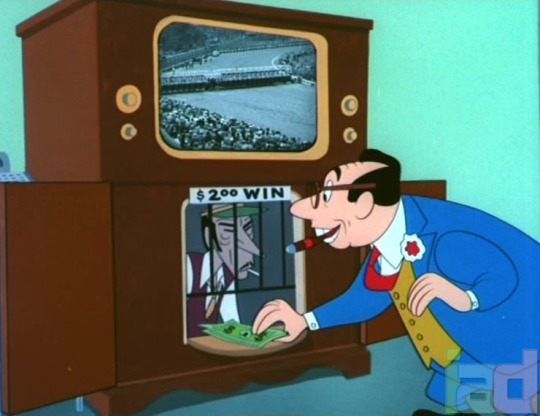
10. T.V. of Tommorow A decent one I remember seeing as a kid. Not much to say though, it’s mostly a bunch of gags about “future” tv’s based on their viewer’s needs. Some good stuff.. not as good as most of what was here today but still better than the worst of it and still very memorable and part of a memorable tetralogy i’ll probably come back to when I do Tex’s birthday again next year. Not a bad note to end on though.
Overall these shorts show just how strong a creator tex was, gleefully taking convention and ripping it to tiny pieces. As i’ve mentioned many times i’ll be coming back to his work next year.. and probably be watching a hell ofa lot more in the time between. Might even do a second special on him in between birthday ones. We’ll see how this does. The Tom and Jerry one sadly wasn’t quite the hit I hoped.
Until then I have many other reviews. And since Today (This review is late) was supposed to be the 90′s tom and jerry movie but that turned out not to be on Max for some reason. I still plan to cover it some day i’ll just have to find it and buy it first. But tommorow if I have the time i’ll be continuing the Lena retrospective with an intresting little side trip. So until then, i’ts been a pleasure and you know what? Thanks for reading.
#tex avery#droopy#bugs bunny#porky pig#the gold diggers of 49#cecil turtle#tortoise beats hare#the heckling hare#tv of tommorow#dumb hounded#red hot riding hood#who killed who#red#spike#bad luck blackie#screwy squirrel#screwball squirrel#owl jolson#I love to singa
27 notes
·
View notes
Photo
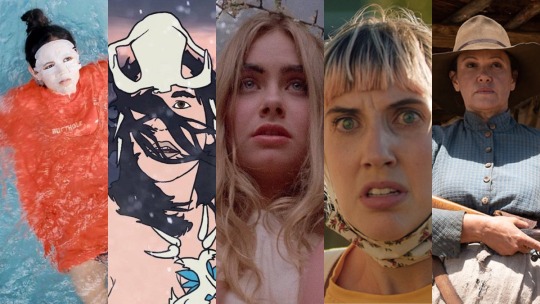
Best of SXSW 2021.
From properly good Covid comedies to an epic folk-horror doc and an Indigenous feminist Western, the Letterboxd Festiville team reveals their ten best of SXSW Online.
We dug out old lanyards to wear around the house, and imagined ourselves queuing up the block from The Ritz (RIP). We dialled into screenings and panels, and did our level best to channel that manic “South By” energy from our living rooms.
The SXSW festival atmosphere was muted, and that’s to be expected. But the films themselves? Gems, so many gems, whether shot in a fortnight on the smell of an oily stimulus check, or painstakingly rotoscoped over seven years.
When we asked SXSW Film director Janet Pierson what she and her team were looking for this year, she told us: “We’re always looking for films that do a lot with little, that are ingenious, and pure talent, and discovery, and being surprised. We’re just looking for really good stories with good emotional resonance.” If there was one common denominator we noticed across this year’s SXSW picks, it was a smart, tender injection of comedy into stories about trauma, grief, unwanted pregnancy, chronic health conditions, homelessness, homophobia and, yes, Covid.
It’s hard to pick favorites, but here are the ten SXSW features and two short films we haven’t stopped thinking about, in no particular order.

Recovery Directed by Mallory Everton and Stephen Meek, written by Everton and Whitney Call
“Covid 19 is in charge now” might be the most hauntingly funny line in a SXSW film. In Recovery, two sisters set out on a haywire road trip to rescue their grandmother from her nursing home in the wake of a severe Covid 19 outbreak. There’s no random villain or threat, because isn’t being forced to exist during a pandemic enough of a threat in itself? If ever we were worried about “Covid comedies”, SXSW managed to flush out the good ones. (Read about the Festiville team’s other favorite Covid-inflected comedies, including an interview with the directors of I’m Fine (Thanks for Asking).)
Alex Marzona praises the “off-the-charts chemistry” between leads Mallory Everton and Whitney Call. Best friends since they were nine, the pair also wrote the film, with Everton co-directing with Stephen Meek. Every laugh comes from your gut and feels like something only the cast and crew would usually be privy to. “You can tell a lot of the content is improvised, which just attests to their talent,” writes Emma. Recovery doesn’t make you laugh awkwardly about how awful the last year has been—rather, it reminds you that even in such times there are still laughs to be had, trips to be taken, family worth uprooting everything for. Just make sure you’ve packed enough wet wipes for the road, and think long and hard about who should babysit your mice. —EK
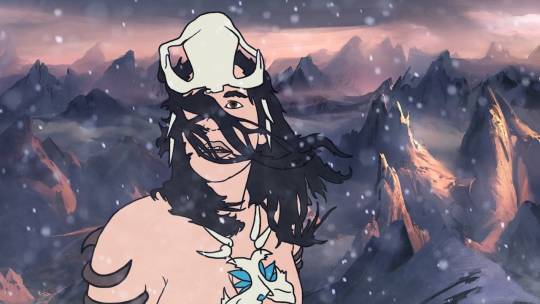
The Spine of Night Written and directed by Morgan Galen King and Philip Gelatt
Don’t get too attached to any characters from its star-studded cast—nobody is safe (or fully-clothed) in The Spine of Night’s raw, ultra-violent and cynical world. Conjured over the last seven years, directors Philip Gelatt and Morgan Galen King’s rotoscoped epic recaptures the dazzling imagination and scope of their influences Ralph Bakshi and Heavy Metal. Approaching an anthology-style structure to explore how ‘absolute power corrupts absolutely’—a proverb more potent now than when Gelatt and King began their project—the film packs a franchise’s worth of ideas in its 90-minute runtime. Though the storytelling justifiably proves itself overly dense for some, it will find the audience it’s after, as other Letterboxd members have declared it “a rare treat” and “a breath of fresh air in the feature-length animation scene”. For sure, The Spine of Night can join Sundance premieres Flee and Cryptozoo in what’s already a compelling year for unique two-dimensional animation. —JM
Kambole Campbell caught up with Gelatt and King (who are also Letterboxd members!) during SXSW to talk about animation inspirations and rotoscoping techniques.
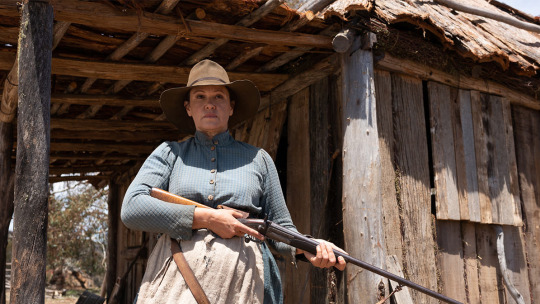
The Drover’s Wife: The Legend of Molly Johnson Written and directed by Leah Purcell
Snakes, steers and scoundrels beware! Writer-director-star Leah Purcell ably repurposes the Western genre for Aboriginal and female voices in The Drover’s Wife. Molly Johnson is a crack-shot anti-heroine for the ages, in this decolonized reimagining of a classic 1892 short story by Henry Lawson. And by reimagining, we mean a seismic shift in the narrative: Purcell has fleshed out a full story of a mother-of-four, pregnant with her fifth, a missing husband, predatory neighbors, a mysterious runaway and a young English couple on different paths to progress in this remote Southern land. Purcell first adapted this story for the stage, then as published fiction; she rightly takes the leading role in the screen version, too.
As a debut feature director, Purcell (Goa-Gunggari-Wakka Wakka Murri) already has a firm grip on the macabre and the menacing, not shying away from violence, but making very careful decisions about what needs to be depicted, given all that Molly Johnson and her family are subjected to. She also sneaks in mystic touches, and a hint of romance (local heartthrob Rob Collins can take us on a walk to where the Snowy widens to see blooming wildflowers anytime). Judging by early Letterboxd reviews, it’s not for everyone, but this is Australian colonization through an Indigenous feminist’s eyes, with a fierce, intersectional pay-off. “Extremely similar to a vast majority of the issues and themes explored in The Nightingale,” writes Claira. “I’m slowly realizing that my favorite type of Westerns are Australian.” —LK, GG

Swan Song Written and directed by Todd Stephens
Udo Kier is often the bridesmaid, rarely the bride. Now, after a lifetime of supporting roles ranging from vampires and villains to art-house muse, he finally gets to shine center-stage in Swan Song. Kier dazzles as a coiffure soothsayer in this lyrical pageant to the passage of queer times in backwater Sandusky, Ohio. “He is absolutely wonderful here,” writes Adrianna, “digging deep and pulling out a mesmerizing, deeply affecting and emotionally textured performance, proving that he’s an actor with much more range than people give him credit for.”
A strong supporting cast all have melancholy moments to shine, with Linda Evans (Dynasty), Michael Urie (Ugly Betty) and Jennifer Coolidge (Legally Blonde) along for the stroll. Surreal camp touches add joy (that chandelier, the needle drop!) but by the end, the tears roll (both of joy and sadness). Writer-director Todd Stephens ties up his Sandusky trilogy in this hometown homage, a career peak for both him and Kier. Robert Daniels puts it well, writing that Swan Song is “campy as hell, but it’s also a heartfelt LGBTQ story about lost lovers and friends, vibrant memories and the final passage of a colorful life.” —LK
Leo Koziol spoke with Todd Stephens and Udo Kier during SXSW about Grace Jones, David Bowie and dancing with yourself.
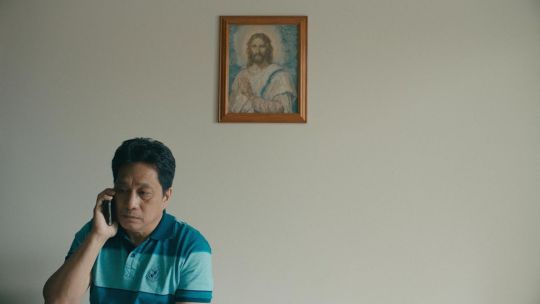
Islands Written and directed by Martin Edralin
Islands is a Mike Leigh-esque story that presents a Canadian Filipino immigrant family full of quirk and character, centered around Joshua, a reticent 50-year-old homebody son. The story drifts in and out of a deep well of sadness. Moments of lightness and familial love make the journey worthwhile. “A film so Filipino a main plot device is line-dancing,” writes Karl. “Islands is an incredibly empathetic film about what it’s like to feel unmoored from comfort. It’s distinctly Filipino and deals with the psychology of Asian culture in a way that feels both profound and oddly comforting.” In a year in which we’ve all been forced to physically slow down, Islands “shows us how slow life can be,” writes Justin, “and how important it is to be okay with that.” Rogelio Balagtas’s performance as Joshua—a first-time leading role—won him the SXSW Grand Jury Award for Breakthrough Performance. —LK

Ninjababy Directed by Yngvild Sve Flikke, written by Flikke with Johan Fasting and Inga H. Sætre
Ninjababy is as ridiculous as its title. When 23-year-old Rakel finds herself accidentally pregnant, scheduling an abortion is a no-brainer. But she’s way too far along, she’s informed, so she’s going to have to have the baby. The ensuing meltdown might have been heartbreaking if the film wasn’t so damn funny. Ninjababy draws on the comforting and familiar (“Lizzie McGuire if she was a pregnant young adult,” writes Nick), while mixing shock with originality (Erica Richards notices “a few aggressive and vulgar moments [but] somehow none of it seemed misplaced”).
An animated fetus in the style of Rakel’s own drawings appears to beg and shame Rakel into motherhood while she fights to hold onto her confidence that not wanting to be a mother doesn’t make her a bad person. Ninjababy’s greatest feat is its willingness to delve into that complication: yes, it’s righteous and feminist and 21st-century to claim your own body and life, but that doesn’t mean it’s easy to turn away from something growing inside of you. It’s a comedy about shame, art, finding care in unlikely places—and there’s something in it for the gents, too. The titular ninjababy wouldn’t leave Rakel alone, and it’s unlikely to leave you either. Winner of the SXSW Global Audience Award. —SH
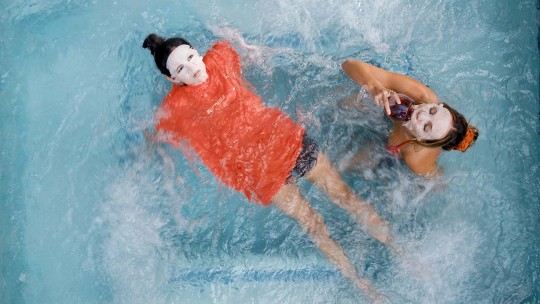
The Fallout Written and directed by Megan Park
Canadian actress Megan Park brought the youthful wisdom of her days on the teen drama series The Secret Life of the American Teenager to her first project behind the camera, and it paid off. Following the scattered after-effects of a school shooting, The Fallout may be the most acute, empathetic depiction of childhood trauma on screen in recent memory. “It sneaks up on you with its honesty and how it spends time with its lead, carried so beautifully by Jenna Ortega. Even the more conventional moments are poignant because of context,” writes Kevin L. Lee. Much of that “sneaky” honesty emerges as humor—despite the heavy premise, moments of hilarity hang on the edges of almost every scene. And Ortega’s portrayal of sweet-but-angsty Vada brings self-awareness to that humor, like when Vada’s avoidant, inappropriate jokes with her therapist reveal her desperation, but they garner genuine laughs nonetheless.
In this debut, Park shows an unmatched understanding of non-linear ways that young people process their pain. Sometimes kids try drugs! Sometimes they scream at their parents! But more often than not, they really do know what they want, who loves them, and how much time they need to grieve (see also: Jessie Barr’s Sophie Jones, starring her cousin Jessica Barr, out now on VOD and in theaters). The Fallout forsakes melodrama to embrace confusion, ambiguity and joy. Winner of both the SXSW Grand Jury and Audience Narrative Feature Awards, and the Brightcove Illumination Award. —SH
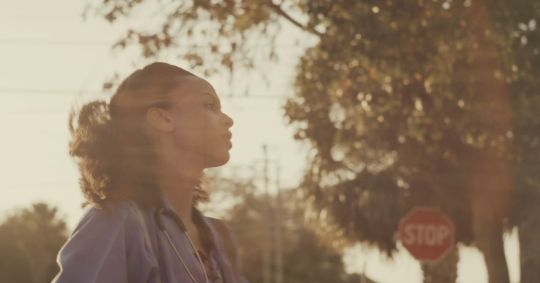
Ludi Directed by Edson Jean, written by Jean and Joshua Jean-Baptiste
When Ludi begins, it’s quiet and dreamy. The film’s opening moments conjure the simple pleasures of the titular character’s Haitian heritage: the music, the colors, the people. Ludi (Shein Monpremier) smiles to herself as she starts her morning with a tape recording her cousin mailed from Haiti to Miami, and listens as her family members laugh through their troubles before recording an upbeat tape of her own. But that’s where the dreaminess ends—Ludi is an overworked, underpaid nurse picking up every shift she possibly can in order to send money home. Writer-director Edson Jean fixates on the pains and consequences of Ludi’s relentless determination, which comes to a head when she moonlights as a private nurse for an old man who doesn’t want her there.
Ashton Kinley notes how the film “doesn’t overly dramatize or pull at false emotional strings to make its weight felt. The second half of the feature really allows all of that to shine, as the film becomes a tender and empathetic two-hander.” George’s (Alan Myles Heyman) resentment of his own aging body steps in as Ludi’s antagonist. Jean throws together jarring contrasts: George throwing Ludi out of the bathroom, followed by Ludi’s memories of home, followed by another lashing out, followed by a shared prayer. The tension is unsustainable. By interspersing the back-breaking predicament of a working-class immigrant with the sights and sounds of the Caribbean, Ludi elegantly, painfully reveals what the cost of a dream can be. —SH
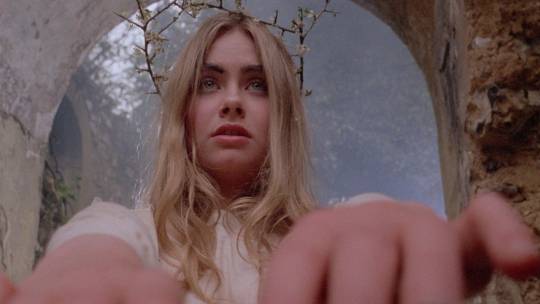
Woodlands Dark and Days Bewitched: A History of Folk Horror Written and directed by Kier-La Janisse
Building on the folk horror resurgence of films like The Witch and Midsommar, Kier-La Janisse’s 193-minute documentary Woodlands Dark and Days Bewitched is a colossal, staggering undertaking that should school even the most seasoned of horror buffs. “Thorough is an understatement,” says Claira.
Combining a historian’s studied, holistic patience with a cinephile’s rabid, insatiable thirst, the film, through the course of six chapters, broadens textbook British definitions, draws trenchant socio-political and thematic connections, debunks myths and transports viewers to far-flung parts of the globe in a way that almost feels anthropological. As Jordan writes, “Three hours later and my mind is racing between philosophical questions about the state of hauntology we generationally entrap ourselves in, wanting to buy every single one of the 100+ films referenced here, and being just a bit in awe of Janisse’s truly breathless work.” An encyclopedic forest worth losing yourself in—get ready for those watchlists to balloon. Winner of the SXSW Midnighters Audience Award. —AY
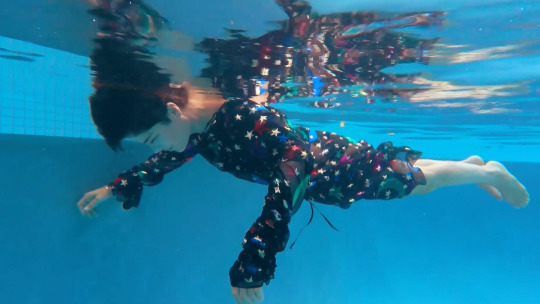
Introducing, Selma Blair Directed by Rachel Fleit
There’ll likely be some level of hype when this intimate collaboration between actress Selma Blair and filmmaker Rachel Fleit comes out later in the year on Discovery+, and that’s okay, because that is Blair’s intention in sharing the details of her stem-cell transplant for multiple sclerosis. There’d be little point in going there if you are not prepared to really go there, and Introducing, Selma Blair is a tics-and-all journey not just into what life is like with a chronic condition, a young son, and a career that relies on one’s ability to keep a straight face. It’s also an examination of the scar tissue of childhood, the things we are told by our parents, the ideas we come to believe about ourselves. “I almost felt like I shouldn’t have such intimate access to some of the footage in this documentary,” writes Andy Yen. “Bravo to Selma for allowing the filmmakers to show some truly raw and soul-bearing videos about her battle with multiple sclerosis that make us feel as if we are as close to her as family.” —GG
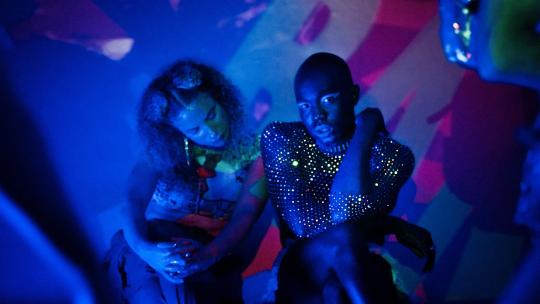
Femme Directed by Sam H. Freeman and Ng Choon Ping
I May Destroy You fans, rejoice: Paapa Essiedu, who played Arabella’s fascinating best friend Kwame, takes center stage in Sam H. Freeman and Ng Choon Ping’s intoxicating short film Femme. It’s a simple premise—Jordan, a femme gay man, follows his drug dealer (Harris Dickinson, mastering the sexually repressed brusque young man like no one else) home to pick up some goods on a night out. Except, of course, it’s not that simple. The co-directors build a world of danger, tension and electricity, with lusciously lensed scenes that lose focus as the threat rises. Frankie calls it “hypnotizing and brutal and gorgeous” and we couldn’t agree more. A crime thriller wrestling with hyper-masculinity seen through the eyes of an LGBTQ+ character, with a sucker-punch ending to boot, the world needs more than twenty minutes of this story. —EK
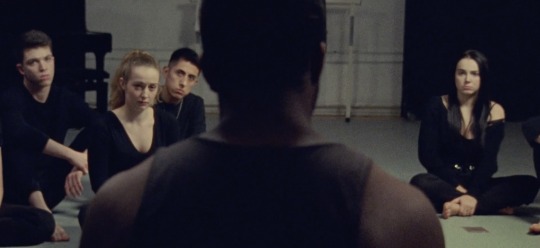
Play It Safe Directed by Mitch Kalisa
If you (unwisely) thought that the vulnerable, progressive environment of drama school would be a safe space for Black students, Play It Safe confirms that even a liberal bunch of actors (and their teacher) are capable of being blind to their own egregiously racist microagressions. Mitch Kalisa’s excellent short film explores structural prejudice head-on, in an electric acting exercise that rests on where the kinetic, gritty 16mm camera is pointing at every pivotal turn. At first, we’re with Black drama student Jonathan Ajayi as he receives the assignment; then we are with the rest of the class, exactly where we need to be. “Literally in your face and absolutely breathtaking,” writes Nia. A deserving winner of the SXSW Grand Jury and Audience narrative shorts prizes. —GG
Follow the Festiville team on Letterboxd
#sxsw#south by southwest#sxsw 2021#sxswonline#SXSW Film#janet pierson#film festival#letterboxd#letterboxd best
8 notes
·
View notes
Text
The ACE Reports - The Lost Superstars
“Buongiorno everyone and welcome to the first episode of the ACE Reports. S here to bring you on a deep dive into the secret files of this esteemed agency. For our first go around I decided to cover something a bit off-kilter but I think you’ll enjoy it.”
“If you’re a fan of Hanna-Barbera or just of animation in general then you more than likely have heard of the Superstars 10. For those unaware the Superstars 10 were a series of made-for-tv movies that were focused on some of Hanna-Barbera’s most iconic characters. If you grew up in the 90′s to the early 2000′s then you likely saw some, if not all of them, on Cartoon Network’s Cartoon Theatre. (You know when Don LaFontaine did the commercials and previews) The concept was honestly brilliant. A series of movies focused on HB’s most well known characters but created for a televised format across the course of two years. It was a good way of showing how big the characters of the brands involved could actually go while still being affordable in doing so for the studio. The films would continue to be rerun in syndication for years after premiering, admittedly some more than others, keeping them in the public mind. It seems the studio was emboldened by the project because they actually planned to release a second wave of movies. Unfortunately corporate and executive concerns killed the plans for that idea. Around the time Hanna-Barbera would have been working on this the studio was acquired by Turner, which put a halt to everything in development at the time which included the planned Superstars films. This resulted in almost every planned project by Hanna-Barbera being scrapped entirely.”
“I consider this to be just plain unfair so I decided that today we would go over what this scrapped second wave of movies would have been about. We’ll be covering everything I’ve been able to discover about these Lost Superstars movies, the plots and characters behind them and some assorted trivia. Let’s get started.”
“We’ll begin by going over a movie that was actually planned for the first set of films in the Superstars 10 but wound up retooled for whatever reason. HB had actually planned to release a Wacky Races movie in the first wave called Around The World With The Wacky Racers. I wasn’t able to find out much about the plot but it seems that it was meant to be global version of the usual Wacky Races from the cartoon. Hanna-Barbers didn’t seem to have the most confidence about a movie based on Wacky Races though because they wound up reworking the idea into Yogi’s Great Escape, the first of the Superstars 10 movies released. I honestly do wish they had released Around The World. Great Escape is a decent movie but it’s one of the weaker Yogi projects HB has released in my opinion. And Yogi got three movies in the series, tying with Scooby-Doo for the number of films in the series it received. HB had no problem with going for less well known properties with the projects it made, considering Top Cat got a movie. Then again Jetsons technically got two movies in the series, one more than it’s inspiration The Flintstones got, so who knows what HB was thinking.”
“Now something interesting is that two of the planned second wave of films actually did get made. The first of these was A Flintstone’s Christmas Carol which released in 1994. The second was Jonny’s Golden Quest, which was a Jonny Quest film and released in 1993. Golden Quest came about in part because of interest from the USA Network, making it a rare project from Hanna-Barbera at the time that could be developed under Turner’s restrictions. I was surprised to discover these movies were actually part of an esteemed pedigree as intended additions to the Superstars 10 line. Golden Quest is also the only movie that falls under the Superstars 10 umbrella that didn’t air on Cartoon Theatre so it’s a bit more obscure. I honestly didn’t know about until I saw the film in channel listing for Boomerang years ago and I didn’t know right away that it was about Jonny Quest.”
“Moving on from the projects that got lucky let’s turn our focus to the ideas that didn’t luck out. One of them was a sequel to The Jetsons Meet The Flintstones, which would have reunited the stone age and space age families. They would have been sent through time again but this time to Rome where they would meet the cast of The Roman Holidays, a lesser known Hanna-Barbera sitcom cartoon. This is the only confirmed sequel idea I know about and it’s honestly a shame it didn’t get made. Not only would the sequel concept be original but it would also introduce audiences to a less well known HB property. I would certainly call that a missed opportunity.”
“Speaking of sequels there is some speculation that the Scooby movies were meant to receive some as part of the second set of movies. If I’m being honest I could only see two of them getting sequels. Reluctant Werewolf would be the frontrunner for me given it’s ending but I could see Ghoul School getting one too. The original characters from there are very popular, even to this day. So much so that they actually made a guest appearance in OK KO. I’ve also read there were ideas for another Top Cat movie but I haven’t been able to find anything about it.”
“Now that we’ve covered follow up, let’s discuss original ideas. I have found there was a plan for another Yogi movie that would have seen Yogi being shipped off to Russia and meeting Russian counterpart to himself called Yaki Bear. I haven’t found anything else about the idea but I do think it would have been a strictly Yogi project like Invasion of the Space Bears was. No appearances by any other Hanna-Barbera funny animals like Huckleberry Hound or Snagglepuss. If that was the case I think it would have turned out pretty well. Invasion was honestly very good in my opinion and it would be interesting to see if they could recapture that feeling with this.”
“Now most of what I know about this second set of movies comes from what I’ve read. But what actually clued me in about the existence of this second wave of Superstars 10 movies was an image of posters for some of the projects I found on Reddit. One of these was for Droopy Master Detective. This idea did see life as a cartoon of it’s own and I haven’t found anything corroborating it as a planned film by Hanna-Barbera but for the sake of argument let’s say it was intended as a film. This would have been very unexpected and I honestly don’t know if they could have done it or not. I don’t really have strong opinions on Droopy and it’s a coin toss if he could carry his own movie or not. The original Superstars movies do hold up so I’ll be cautiously optimistic.”
“Another one of the posters I found was for a Quickdraw film.”

“Titled The Quickest Draw In The West it seems it would have been another western, much like the Huckleberry Hound one was. Quickdraw would have gotten a love interest and presumably he would have been in conflict with some character or other to prove himself as the Quickest Draw In The West. I’ll be honest, this one seems like a coin toss on working to me. HB already did the western story with Huckleberry Hound and going by the poster it doesn’t seem like they would have included any other funny animal characters. Quickdraw is fun, especially with his El Kabong persona, but it’s iffy as to whether he could carry his own movie.”
“The final project I’m aware of was of all things, a Magilla Gorilla movie.”

“This is surprising and quite honestly this project is the most intriguing of the scrapped Superstars 10 projects for me. For starters Magilla has always been a backburner character for HB, most of his appearances and focus have tended to be in ensemble shows and even there he’s rarely a figure of prominence. I believe the most stand out focus he’s ever gotten has been in a DC comics special issue where he crossed over with Nightwing. And even there he had to share screen time with Grape Ape. So making him the star of the film was a unique choice to say the least.”
“And speaking of unique choices this is probably the project that we can divine the most details about, going by the poster. The title is appropriate for a Hanna-Barbera work, being called A Night at the Ape-ra. It just feels like some of that old HB magic with that title. Magilla would have gotten a love interest, which is the least stand out thing in these details. Wally Gator and Top Cat would have also factored in. It’s not clear how exactly but presumably they would be friends to Magilla. Dick Dastardly and Muttley seem to be the ones chosen as the villains for the film which definitely stand out. These two were prohibited from appearing in Hanna-Barbera productions for a long time, owing to ownership disputes regarding the characters. This necessitated Hanna-Barbera creating copies in the form of the Dread Baron and Mumbly, who appeared in the Spruce Goose movie. So seeing them planned as the villains is a bit of a surprise. If HB would have been able to include the duo is another question altogether.”
“It’s unclear exactly what the plot would have been but the details in the poster do give something of an idea as to what it might have been. Magilla wants to sing at the opera, that much is easy to discern. Dastardly and Muttley are the villains and trying to capture him. Going by Dastardly’s attire it’s quite likely he’s a zookeeper and with that in mind it could paint the picture that he’s either trying to capture Magilla for the zoo or trying to return him there. Either or would work in the context of the story. A zoo setting would also be an ideal way of including Wally Gator whose zoo life factored into his own show and his appearance in Great Escape. Top Cat is an odd duck in this situation but he could have factored in as someone who knows the streets that helps Magilla get to the opera given that one of lines hints that Magilla actively wants to sing at one.”
“Story speculation aside I honestly wish I could have seen this one. If I had to choose any of the scrapped projects to be made today it would be this one. The idea of Magilla as a lead is certainly something different and having an ensemble showing that lacked Yogi Bear would only make it more unique. Having it be a full blown musical would also make it stand out. The music in these movies was always stand out and phenomenal *remembers Scrappy’s rap from Ghoul School* well mostly, and seeing a project that was a full blown musical would only take it to a new level.”
“All in all the Lost Superstars were an intriguing idea that will forever plague the minds of those who know of them, wondering what might have been if the almighty dollar had not struck them down. There were ideas that may not have changed the world but might have given us a good time regardless. All we can do is walk the web, praying that one day we’ll find out just one more word that could describe this lost art.”
“So for now we look to the stars, and wish that somewhere, someday we may see these Lost Superstars again. Volare via everyone.”
2 notes
·
View notes
Note
Thd Haunting anthology for the ask game! :)
Thank you, my friend!! Sorry I took so long, lol.
Top 5 favourite characters:
This is hard.
1. Theo Crain
2. Dani Clayton
3. Hannah Grose
4. Luke Crain
5. Viola Willoughby
Other characters you like:
It would be a lot easier to just name the characters I don’t like. These characters are so well-written and have so much depth. So if I don’t mention them in the next question, assume I like them.
Least favourite characters:
Peter fuckin’ Quint, Joey (Luke’s “friend” from rehab,) and Henry Wingrave.
Otps:
This show has more of my OTPs than any other. Hannah x Owen, Jamie x Dani, and Nell x Arthur.
Notps:
Luke x Joey, Perdita x Arthur (Viola’s husband,) Becca x Peter
Favourite friendships:
Theo and Shirley, Luke and Steve, and Hannah and Jamie.
Favourite family:
The Crains own my heart, obviously, but what I loved best about BM over HH is that found family dynamic the main group develops.
Favourite episodes:
Touch, The Bent-Neck Lady, Two Storms (!!!!!!!!!! this episode oh my god,) Screaming Meemies, Silence Lay Steadily, The Way It Came, The Altar of the Dead, The Romance of Certain Old Clothes, and The Beast in the Jungle.
Favourite season/book/movie:
I always say this: THOHH is a masterpiece, and THOBM is a really, really exceptionally good show. I do prefer HH, but only by a tiny bit.
Favourite quotes:
“You have loved me, so I will always be here [in your heart.]” - Owen to Hannah. I’ve heard a thousand variations on this theme, but for some reason, the delivery and context of this line broke me. I always cry.
“You loved me completely. And I loved you the same. The rest is confetti.” - Nellie to her siblings. Rip me wide open!!
Best musical moment:
I really like the score of this show, but no one song or moment sticks out.
Moment that made you fangirl/boy the hardest:
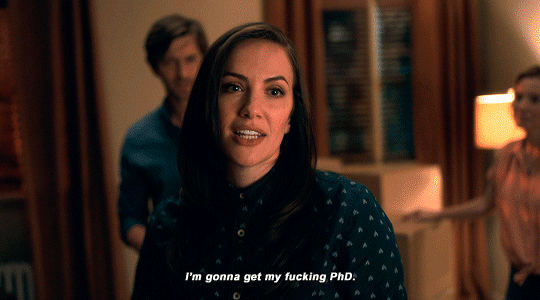
When it really disappointed you:
It never did. I think these two shows are some of the best television ever created.
Saddest moment:
Picking a top five (in no particular order,) since these are inherently sad and tragic shows...
1. Rebecca’s forced suicide at Peter’s hand.
2. Nellie’s death and realization that she is the Bent-Neck Lady.
3. Luke’s reaction to Nellie’s death - how he could literally feel it.
4. Jamie going to the lake and seeing Dani’s body and begging her to take her, too.
5. Dani having sleep paralysis and being unable to help Arthur when he has an aneurism.
Most well done character death:
I mean, they’re all really good and well-done. Appropriately heart-wrenching, shocking, and they all work in context of the plot. If I had to choose just one, it would probably be Nellie’s, since it’s the basis of the entire first season. The hints about the Bent-Neck Lady and the way we slowly get to know Nellie, and then come to love her the most right as she’s finally about to die - ugh, so good, so sad.
Favourite guest star:
Kate Siegel as Viola Willoughby.
Favourite cast member:
Victoria Pedretti is a goddamn delight. She’s an incredible actress - so raw and real and compelling. She’s a stoner IRL and seems super chill during interviews. I would love to share a joint with her someday. (If I ever share a joint with anyone ever again, thanks coronavirus.)
Character you wish was still alive:
Rebecca Jessel really deserved better, man. :( Fuck Peter Quint.
One thing you hope really happens:
Well, the series is officially on a semi-permanent hiatus. Mike Flannagan said he has no plans for future seasons in this universe. He is currently finishing up work on another horror show, Midnight Mass, so I’m looking forward to that. I would love to see more from this universe and this cast, though.
Most shocking twist:
The Bent-Neck Lady, for sure. So well foreshadowed, and still so shocking when the realization hits. My stomach dropped through the soles of my feet.
When did you start watching/reading?:
I caught this bandwagon pretty early - only a week or two after the first season premiered. I remember watching and realizing they had synced up the show’s timeline with real life - if you watched in 2018, Nellie dies that same year, and her date of death was just a week or two after the premiere. An extra little detail that made me very sad.
Best animal/creature:
There are no good animals in this show, lol. Fuck those kittens.
Favourite location:
Bly Manor is soooo pretty.
Trope you wish they would stop using:
I really hate anything with animals suffering in horror, so I just hope that never comes up again.
One thing this show/book/film does better than others:
Everything.
...
Okay, okay. The plotlines are very clever and super well-done.
Funniest moments:
Dani sleeping in the back of Owen’s car with her mouth wide open; Theo’s “I’m gonna get my fucking PHD;” like, most of what Theo said in general.
Couple you would like to see:
All I can say is that Hannah and Owen deserved Paris.
Actor/Actress you want to join the cast:
Meh. No opinion.
Favourite outfit:
I really loved the 80s and 90s looks in Bly. Dani’s jean jacket. Jamie’s looks when she and Dani are together later in life. All A+.
Favourite item:
Moonflowers.
Do you own anything related to this show/book/film?:
Nah.
What house/team/group/friendship group/family/race etc would you be in?:
I gotta go with the found family at Bly. Jamie, Dani, Hannah, Owen, the kids. They clearly had a lot of fun together, and I’m a sucker for found family.
Most boring plotline:
I gotta go with Henry Wingrave’s doppelganger. It didn’t really do much for me, and I think the episode that centers on him, while showing important exposition, was one of the weakest in the anthology.
Most laughably bad moment:
I can’t think of one.
Best flashback/flashfoward if any:
The entirety of “The Romance of Certain Old Clothes”
Most layered character:
I would argue Olivia Crain. She starts out as a creative, kind, loving mother, and is slowly unraveled by the house - but that core of goodness is still inside her, and still motivates everything she does.
Most one dimensional character:
I think this show does a great job of making all of its characters complex and interesting. I wish we had learned more about Joey, but I think she’s meant to be unsympathetic on some level. But at the end of the day, she’s kind of just Luke’s addict almost-girlfriend, and a pretty weak character among much better ones.
Scariest moment:
Ooooh, that’s tough. I think for me, it’s when Steve sees Nellie’s ghost. It’s not a super spooky episode, up to that moment. But that close-up shot of Nellie’s graying, dead face, her eyes all fucked up, her mouth gaping open unnaturally wide - and the sound she makes. Woof. Ugh. Aaaaah. It’s a lot.
Grossest moment:
The kittens. Enough said.
Best looking male:

Best looking female:
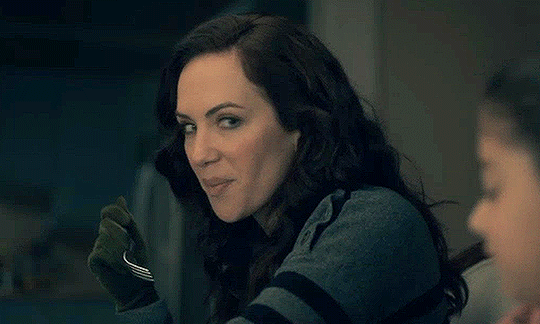
Who you’re crushing on (if any):
I’ll always be a little in love with Kate Siegel.
Favourite cast moment:
I’ve never really looked for cast content.
Favourite transportation:
Theo’s Jeep.
Most beautiful scene (scenery/shot wise):
I just think Bly is so pretty. Most of the overhead or scenery shots of it are really nice.
Unanswered question/continuity issue/plot error that bugs you:
There aren’t any. Anyone who tells you otherwise misunderstood something.
Best promo:
I intentionally avoided promo to avoid spoilers.
At what point did you fall in love with this show/book:
The end of the very first episode of Hill House!
I’m not doing anymore of these ‘cause I’m bad at answering them!!
3 notes
·
View notes
Text
Gotham’s 31 Most Wanted - Number 24
Welcome back to Gotham’s 31 Most Wanted! Each day of January, I’m counting down my Top 31 Favorite Batman Villains of all time! Sharpen your cutlasses; skullduggery is ahead! Number 24 is…The Cavalier.

Now, unless you happen to be a major comic book geek, the chances are you’re wondering, “Who the heck is the Cavalier?” Would you believe me if I told you that, at one time, he was Batman’s #3 opponent – a villain in the same ranks as Joker and Penguin? I’m not even kidding. That was how this character started. I have a lot to say here, so I’ll try to keep things as brief as possible, but here’s the quick history: the Cavalier was originally conceived in the middle of the Golden Age of Comics. Back then, his name was Mortimer Drake, and he was actually one of those great villains who, in many ways, was a parallel to Batman: Drake was a millionaire (and highly-trained fencer) in the same league and circle as Bruce Wayne. Mortimer was an eternally bored man with a love of old-fashioned swashbuckling films. Seeking thrills and adventure, he donned makeup, a wig, and a Musketeer-inspired costume to become the gentleman thief, Cavalier. Throughout 1943 and 1944, the Cavalier was all over the place, making several appearances and being outright compared to the likes of Joker and Penguin as one of the Dynamic Duo’s greatest adversaries… …Then, in 1945, well…the Cavalier didn’t DISAPPEAR, but he certainly took a step downward. After that point, the Cavalier’s appearances became increasingly more spread-out, his roles in stories became more minor (sometimes just cameos), and even though he continues to make appearances even to this day, he has certainly fallen from grace. I think part of the reason for this is that the Cavalier, in this style, was a villain who fit in perfectly in his time period, but writers perhaps found it hard to keep him going. As the times changed, the Cavalier couldn’t keep up. Even nowadays, while he’s not exactly treated as a loser or a joke, he’s certainly not a villain most people take too seriously. How can you? He’s not a character who can really function well in a modern setting… …Or can he?
This is where things get interesting: if Mortimer Drake is a bit of an obscure rogue, then chances are you DEFINITELY haven’t heard of the OTHER Cavalier. “What?!” I hear you exclaim. “There are two of them?!” Well…kind of.

In the late 90s, a three-part story arc entitled “Batman: Blades” was published. It was written by James Robinson, with artwork by Tim Sale – the same illustrative genius behind “The Long Halloween” and other related works. This story served as a “reboot” of the character, who was now renamed Hudson Pyle. Instead of a billionaire who turned to crime for fun and thrills, Pyle was a Hollywood stuntman and actor, once again enamored with old-fashioned swashbuckling epics. A skilled fencer, he didn’t actually become a criminal, but instead became a vigilante, who took to the streets with his own brand of justice, garbed in an outfit inspired by Zorro rather than by The Three Musketeers. In fact, the Cavalier turned out to be worthy competition for Batman; while the Dark Knight was tracking down a serial killer at the time, the Cavalier began cleaning up other corners of the City. Being much more flamboyant and “social” than Batman, the Cavalier became something of a hero of the people, being seen almost as a Robin Hood figure. HOWEVER, Pyle’s story became a tragic one, as he fell in love with a beautiful woman who was in the grip of scurrilous knaves. In order to keep her safe, the Cavalier began to commit robberies and even murders, thus turning from vigilante to villain. In the end, the Cavalier revealed that he was actually starting to ENJOY crime, and was afraid of what he could become, so he challenged Batman in a duel to the death. He very nearly killed the Dark Knight, but when the Gotham City Police arrived, he gave up the fight and seemingly died in a confrontation with the officers. “Never bring a knife to a gunfight,” after all. Since then, the Hudson Pyle version of the Cavalier really hasn’t been seen in mainstream comics since, aside from a few cameos (at least to my knowledge; if anyone knows otherwise, please let me know, because I want to read more of him). Weirdly enough, it’s Mortimer Drake who is more frequently seen, and he’s the only version who has made it into other media, as he’s popped up in two different animated series: “Batman: The Brave & the Bold” and “DC Superhero Girls.” I find this saddening, because I actually think the Pyle version is, in several ways, a superior interpretation of the character: if he had been allowed to live at the end of his tale, we could have a lot of fun seeing his descent into further villainy and seeing how he would have bedeviled Batman in the future. He was a more complex character, with a darker look and style that still harkened back to his roots, but fit in a more modern setting…and, on top of that, given the fact Batman is canonically linked to Zorro, his own evidently Zorro-based roots could have been a grand way of tying to the two characters closer together, almost a sort of “Anti-Gray Ghost,” if you will. With that said, I do still like the original Cavalier, too, just for different reasons. In fact, until recently, I forgot how much I loved both these characters, and I seriously, SERIOUSLY wish we could see more of them, in and out of comics. I’m not sure how well the character would do in movies, but I think he could have great potential in video games, and it would be nice to see even more of him in animation, or even on TV. On that note, I’m kind of amazed that he never showed up in the 60s series! He seems perfect for that, don’t you think? Perhaps if he had, he’d be better remembered…but que sera sera. The countdown continues tomorrow, where I’ll be covering my 23rd Favorite Batman Villain. HINT: He’s One of Gotham’s Most Sinister Gangsters.
#gotham's 31 most wanted#january advent calendar#new year's countdown#batman villains#dc#villains#batman#cavalier#mortimer drake#hudson pyle#best#favorites#comics
3 notes
·
View notes
Text
Chapter 9: Into the Unknown
A boy named Mark was born on April 26th, 1976, fourteen years and one day before a boy named, uh, me. We’re both Virginians, but he moved to Florida as a kid while I stayed in the Old Dominion through college. Summers in Virginia are hot and humid and full of mosquitoes, which is why I love winter so much, but summers in Florida are so much worse. Despite that, Mark was an outdoorsy kid, and his adventures along the water inspired a literal dream he had around the time I was born about going on adventures across the seas, a dream that saw him start to make up stories about this alternate self. (I had nothing to do with it, we’ve never met and even if we had I wasn’t a particularly inspirational baby, but after so many introductions about animators of the past, it’s neat to think about how recently this last bit of history spans).
Mark moved to Utah in high school, and his swashbuckling appearance and attitude reminded his new classmates of Thorpe, Errol Flynn’s character in The Sea Hawk (as one of my sources helpfully notes, the reference to a 1940 film is likely due to the more conservative leanings of early 90s Salt Lake City making older films movies more popular). It’d be weird enough for “Thorpe” to become a lifelong nickname based on this tenuous connection, but the nickname Mark ended up with is actually a mispronunciation of name that I guess nobody felt the need to correct. High school, am I right?
Thurop Van Orman began his career in animation as an intern at Cartoon Network, and parlayed that into storyboarding gigs for The Powerpuff Girls and The Grim Adventures of Billy and Mandy. He learned from the likes of Craig McCracken as he honed his idea into a pitch for a show about a kid like him who loved capers on the high seas, and in 2008, the stories inspired by his childhood dream became a cartoon. For two years and three seasons, The Marvelous Misadventures of Flapjack not only entertained with its hilarious and surreal escapades, but incubated a crew of animators that shaped the 2010s.
J. G. Quintel, creator of Regular Show? Flapjack alum. Peter Browngardt, creator of Secret Mountain Fort Awesome and Uncle Grandpa? Flapjack alum. Alex Hirsch, creator of Gravity Falls? Flapjack alum (who brought Thurop in to voice the villainous Gideon). Pendleton Ward, creator of Adventure Time and Bravest Warriors? Flapjack alum, and his continuation of the Flapjack style of storytelling, where writers doubled as storyboarders, would shape Adventure Time alum Rebecca Sugar’s own methodology as she created Steven Universe. This would not be Thurop’s only “grandchild,” as the likes of Bee and Puppycat, Clarence, OK K.O., Summer Camp Island, and Infinity Train were all created from alums of shows created by Flapjack alums, and we’re even starting to see great-“grandchildren” like Craig of the Creek and Victor and Valentino.
But I left out one Flapjack alum who worked with Ward to develop Adventure Time from a viral short with a ton of potential into a sustainable television show, becoming the show’s creative director for the first two seasons. His name was (and still is) Patrick McHale, and in October of 2011, he started working on a pilot of his own.

“The river runs cold, the fight is over; still, the haunted ruins of night call your name.”
A trope that I’ve never been fond of when it comes to twists is when flashbacks are used to remind us of the foreshadowing or give old scenes new context. It can work in the right circumstances, but more often than not it shows a certain lack of trust, either in the audience for not paying attention or in the material for not being memorable, and it sucks the joy out of rewatching the story to catch hints for yourself. I much prefer a twist that maybe gives us a moment to take it all in (which is frankly pretty easy to do, all it takes is a character who’s as stunned as we are to allow us that time to process), and believing in us to understand the ramifications of this twist on our own.
Into the Unknown thrives in its bluntness. There’s no attempt to be clever about the reveal that Wirt and Greg are of our world in the late 20th century, we just begin right away with Wirt wearing semi-modern clothes in a semi-modern bedroom fumbling with a semi-modern cassette, all to the backdrop of a semi-modern-sounding song sung by Pat McHale himself. His actions are confusing at first to match our own initial confusion, creating the outfit we’re familiar with by taking the coat from an old-timey uniform and cutting the fluff off a Santa hat and putting on a fan to let his cloak billow in the wind (it helps that we already know he’s a weird and overdramatic kid). But our questions answer themselves with time: it’s Halloween, Wirt’s planning on giving his crush a mixtape, and Greg's series-spanning kettle hat is just his glorious take on an elephant.
This is Wirt pre-development, so he’s back to the dithering and the abysmally low confidence and the open hostility towards Greg; the last of these makes a comeback when he reaches peak despair, but even while depressed he's moved beyond the crippling indecision of his early adventures (although certainty in one’s looming demise isn’t much better). Still, even this early on we can see that he’s not a lost cause. He might get lightly teased by the first teens we see, but his appearance at the party reveals that he’s liked by plenty of his classmates, and Sara’s mutual crush is immediately obvious: his biggest enemy is his lack of self-esteem. And while he loses his nerve as soon as he sees Sara the Bee, this wouldn’t be possible if he didn’t have nerve in the first place: the beginning of Into the Unknown, and thus the first chronological moments that we see of Wirt, shows him getting out of a funk to take a genuine risk, one that fully merits him dropping the episode’s title on us.
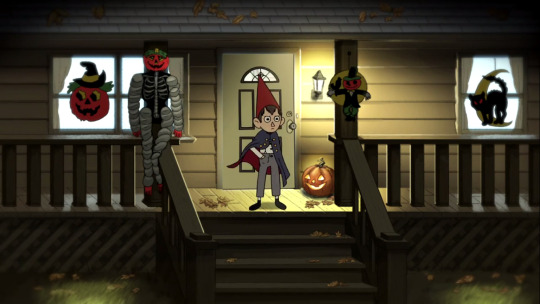
The pursuit of Sara the Bee shifts us wildly from the dark atmosphere of the Unknown to classic teen comedy territory, where one crazy night can change everything. The stakes are fully personal for the bulk of the episode: Wirt needs to get his tape back to avoid embarrassment, and Greg wants to get the tape back so Wirt will hunt frogs with him. I like the detail that Wirt’s been flaking out on his promise and that Greg almost gets that he’s being blown off, but clings to that childish hope as he bulldozes through the barriers Wirt puts up for himself. Greg is first seen as a helper, doing chores for Mrs. Daniels for the candy he’ll use to make a trail in The Old Grist Mill instead of trick or treating, which implies a certain level of neglect: nobody’s around to take him door to door to get candy the proper way, and we don’t see him interact with any kids his age.
That said, the mood of the episode is definitely more mellow than melancholy, with Wirt’s awkwardness earning laughs and cringes in equal measure. Sara is delightful as she assures Wirt (and parents in the audience) that the teens are gonna drink age-appropriate drinks and do age-appropriate stuff, and she’s got the best costume game of anyone, first as a mascot and then as a skeletal clown. The cops try for humor as well, and while it’s funny for us, their position of authority makes them terrible at telling jokes in a way that will come back to haunt us. This is the last bit of levity before the finale, and unlike Babes in the Wood, hindsight never taints its goofiness. Particularly because the greatest joke of the episode, and perhaps the series, is far more upfront about its larger story implications than Greg’s magical dream.
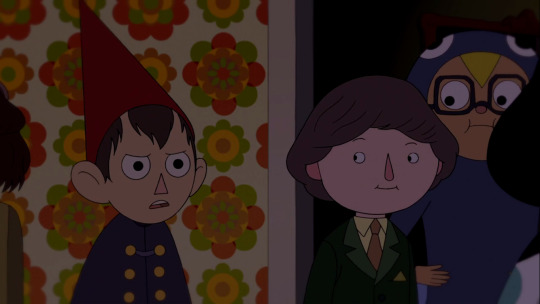
Jason Funderberker is an oddly central character in Over the Garden Wall, a figure of dread established midway through the series as Wirt’s impossibly perfect romantic rival and the eventual namesake of Jason Funderburker. We confirm that Jason is a big deal when Wirt talks to the girls at the big game; sure, most of the impact comes from his outsized reaction, but Jason is still presented as serious competition for Sara’s heart. After going full crisis mode at the thought of Jason and Sara listening to his tape, we get a red herring of sorts in Jimmy the Jock. He certainly fits the “total package” bill that Wirt promised: a kind hunk who clearly respects women’s boundaries but warns Wirt off spying on Sara rather than trying to display his machismo through force. All signs point to a hopeless situation until finally, with perfect comedic timing, we meet the man in question.
It’s not just that Jason Funderberker is small and scrawny, or that his outfit and hair are pretty dorky (that said, let’s consider the source): it’s that damned voice. He’s given an absolutely perfect grating squeak from Cole Sanchez, yet another Flapjack alum who took over as creative director on Adventure Time after McHale moved to New York. The idea that this dweeb is the object of Wirt’s unending jealousy is an amazing punchline by itself, but as I said, the larger story implications are immediately clear, because there’s one thing that truly separates Jason from Wirt: confidence.
Jason might not be the most conventional ladies’ man out there on paper, but unlike Wirt, he’s capable of making a move. He’s as blind to Sara’s lack of interest as Wirt is to Sara’s active interest, but dammit, he tries. And he doesn’t even try in a gross or intrusive way, handling Sara’s implicit rejection well enough and ending up holding hands with his bespectacled admirer in our final episode. Literally all it takes for Wirt to “compete” with this guy is an ounce of self-assuredness, so it tracks that his journey through the Unknown achieves just that.
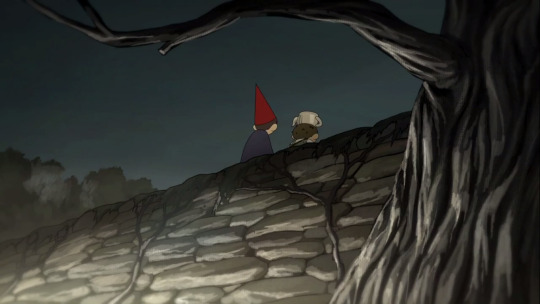
The Unknown might be another realm that these brothers have yet to face, but our understanding of it seeps throughout the episode. There’s the obvious reference to the show’s title as the pair climbs over the wall of the Eternal Gardens cemetery, and the grave of Quincy Endicott in said cemetery, but it’s also felt in the inability for Wirt to see the truth that he’s well-liked and that Sara definitely likes him back. It’s in the recurring bird imagery, with one girl dressed as an egg (who, and I noticed this for the first time in this watch, is voiced by Ashly Burch!) and another as a bluebird. It’s the fact that we’ve got disguises in general because it’s Halloween, considering the sheer amount of characters who aren’t what they appear in the Unknown: Enoch is really a cat, the gorilla is really a circus performer, the ghost is really a tea magnate, the huge singing frog is really our heroes huddled under a big coat, and the devourer is the sweet girl rather than the witch.
The most straightforward character, of course, is Greg. To be as fair to Wirt as I can be, his little brother does throw a wrench in things when he can’t stop giving the girls hints about Wirt’s crush, which sets off the chain reaction leading to what appears to be a disastrous night, so if you squint hard enough, Wirt isn’t wrong to blame the kid for his troubles. But without Greg, Wirt never would’ve gotten the courage to talk to Sara, and he certainly wouldn’t have entered the party uninvited. Greg’s willingness to engage perhaps needs to be tamped down in the same way Wirt’s needs to be amped up, as he has all the social skills of a little kid, but at least Greg has the excuse of, well, being a little kid.
More importantly, Wirt’s instinct to blame everyone but himself makes it impossible for him to see that he’s the one holding himself back. Acceptance and a relationship with Sara are right there in front of him, he just needs the courage to acknowledge it. Greg’s best bit of advice is that he join marching band, given he plays the clarinet anyway and it would allow him to spend time with Sara organically, but Wirt angrily dismisses the suggestion as interference while revealing that Greg’s father has given the same advice. It’s the second and final time we’re reminded that these two are half-brothers, but only now do we bring up that there’s distance between Wirt and his stepfather that seems to be one-sided. As per his song in our fourth episode, Greg was born after Wirt’s mom remarried, so his stepdad has been his stepdad for a significant period of time by now, but Wirt still venomously refers to him as “your stupid dad” as if he’s a stranger, even though the guy is ostensibly encouraging Wirt via his interests. Sure, there could be plenty more to this story that we’re not seeing, maybe the guy’s a huge pushy jerk, but Wirt’s refusal to consider good advice cements his inability to allow himself means of being happy, which of course ensures that he’s never going to be happy.

Which is what makes the ending of Into the Unknown so perfect. After finally finding their frog, the old black train whose whistle we hear at the beginning of nearly every episode nearly kills them, and as they tumble down a hill into the cold-running river foreshadowed by the episode’s opening song (and the opening sequence of the series), everything finally clicks into place: these boys are more lost than they realize.
But when Wirt awakens in the present surrounded by Beatrice’s family, he’s finally able to use the word “brother” to describe Greg. Over the Garden Wall began with a version of Wirt who failed to be heroic even when instructed to be, then moved to a version who could stumble his way through heroics on command, which evolved into a version who could perform heroics autonomously, but now we’ve gone above and beyond: this is a version who’s heroic even when others beg him not to be. We’ve wrapped all the way back around to disobedience, but this time it’s for the sake of helping others. And after dismissing and blaming Greg in the Unknown and the land of the living alike, it’s downright beautiful to see Wirt set off into the unknown once again, willing to put his life rather than his reputation on the line to save his brother.
Rock Factsheet
We come close to learning some valuable rock facts, but Wirt’s too distracted.
Where have we come, and where shall we end?
Beatrice’s mother appears only briefly at the end of the episode, but she’s voiced by musical legend Shirley Jones, and One is a Bird whispers its way out of the final scene. It was pretty much inevitable that Jones was going to sing it.
#into the unknown#over the garden wall#otgw#steven universally#thurop van orman#the marvelous misadventures of flapjack#pendleton ward#adventure time#patrick mchale
101 notes
·
View notes
Note
Hi! First time here to ask haha! Any HCs for La squadra with an Otaku s/o? Like she watches anime and even buys merch in secret cuz she's scared they might find her hobby lame and immature? (Also,what will be their fave anime? And genre?)
Oh boy let me tell you I have some THOUGHTS about these boys and their taste in anime
La Squadra with an Otaku s/o
Risotto
at first he’s gonna be kinda confused, not gonna lie. Growing up the only ‘anime’ he knew was like, Pokemon and Dragon Ball Z but at that point he was too old to really get into Pokemon, and he never considered DBZ anime because it aired next to cartoons and stuff.
But that doesn’t mean he won’t appreciate s/o and their good taste. He’s the kind of guy who wants to learn about what interests the people he loves, and he loves you. So he’d honestly enjoy late nights spent binge watching your favorites.
Comes to realize that DBZ was low key his gym goals for the early years of him working out. If you bought him a ‘Swole like Goku’ tank he’d probably wear it to lift in, ngl.
Knowing your favorites he’d probably look to merch for his go to birthday or Christmas gifts. Considering the hobbies and interests of some of his co-workers, a scantily clad waifu figure is honestly a welcome change of pace.
Depending on the style or aesthetic of the anime (ie, is it goth) he would be down to couples cosplay, although he wouldn’t be comfortable with you posting pictures of his face or any identifiable features of him online
His fave is probably the original Dragon Ball Run, followed very closely by DBZ for the nostalgia bit. Something deep like Full Metal Alchemist (Brotherhood and the original) would also appeal to him
Is also a big fan of Beserk, disappointed by the anime. And Vinland Saga, not disappointed by the anime.
Partial to Princess Mononoke as well. He likes some Ghibli films, isn’t afraid to admit it. Thinks the score for Spirited Away is bomb af.
Prosciutto
Prosciutto doesn’t really get it at first either. Honestly? He probably didn’t know the difference between cartoon and anime until you explained it to him.
Unlike Risotto he might be a bit more judgey if you try to get him to watch some with you. So you gotta hit him with the real classics.
But similarly to Risotto, he at least makes an effort to try and indulge in the things you like. He might not be as patient, but he tries.
Probably wouldn’t do cosplay himself, but would hunt down exclusive seasonal merch to gift you. He’d take careful stock of your collections and do some research to pick out only the finest figurines and posters for you.
Would buy that hella expensive premium bandai apparel for you too, might even pick something subtle up for himself if he really liked the show it came from.
Also back on the cosplay note, if you agreed he’d find the highest quality cosplay possible and have you model some of his favorites for him.
(In particular if you were comfortable in fem clothing, Faye Valentine gets him going)
He loves Cowboy Beebop. 100%, wants to watch it again as soon as it ends. Everything from the characters to the story to the music and the fliud animation that has aged like fine wine appeals to him. Prosciutto is a man who likes the finer things in life. He oozes class. Cowboy Beebop oozes class and prestige.
Also likes Maasaki Yuasa. It was his idea to go see The Night Is Short, Walk on Girl in theaters.
In general his tastes tend to lean towards arthouse type anime or bona fide classics.
Pesci
Pesci knows anime and has been doing his absolute best to keep it a secret from the rest of the gang because they already tease him enough.
He’s one of those secret weebs, you gotta know where to look. Your best bet is to look at his accessories. Is there a watch with a certain symbol from an anime you recognize? A lanyard with a familiar print? Something subtle that isn’t immediately noticed by people not looking for it.
He has a secret box in his room full of blue rays from his faves. He watches them sometimes when he’s home alone. There’s nothing X rated in there obviously, he just doesn’t want people to know.
Thank god he has you.
The two of you probably bonded pretty fast over your mutual love of anime. Hell, you being such an open and proud Otaku probably gave him a bit of confidence in expressing his interests too.
Yall are the weeb couple. Yall definitely go to conventions together. Couples Cosplays, the whole thing.
He’s a sucker for Shonen just as much as he is for the really good heart wrenching painful ones.
He watches Boruto because he loves Naruto so much.
He would also tear up at Clannad.
Dango Daikazoku triggers almost a pavlovian response of heart ache.
So does Secret Base.
Ano Hana is probably his favorite, although even you’d need to pry it out of him. Its one thing that Prosciutto gives him shit for liking anime, its a whole different ball game if he found out Pesci liked girly anime
Fromaggio
He knows what hentai is. That’s about as far as his knowledge went before yall got together.
He thinks its pretty interesting though, so he’d be down to watch some with you.
Turns out he really likes action shonen. He got really, really into One Piece. Like, instantly. He likes the fact there’s so much to watch/read before he’s caught up too.
Another boy that would couples cosplay and be really into it. Especially if it continued into the bedroom.
He’s pretty go with the flow, so he isn’t picky about what y’all watch. Even if it isn’t his cup of tea he’ll sit through a few episodes on a night with you.
Fromaggio can’t tell the difference between a high quality figure and a shitty one. Its a crap shoot what he buys for you. Its more a process of ‘oh, so likes this character’ rather than checking the seams and paint quality and how dynamic the pose is/interchangeable parts.
Definitely buys way too much in the dealers room because of this.
He tries his best.
His fave is probably One Piece, liked bleach a lot but never read the manga, Yu Yu Hakusho is another one he really enjoyed. The Dark Tournament arc had him at the edge of his seat and hype as shit.
Illuso
Had a passing knowledge of anime before dating you. Knew what it was, saw a few of the mainstream ones, thought they were enjoyable, moved on with his life.
Your dedicated interest in anime would surprise him at first, because he always figured it was kind of a niche thing.
Would snoop around your collection of manga/figures/plushes in the mirror world while you sleep.
Winds up reading a lot of your manga like that (he’s good at reading in reverse because of his stand)
He finds he appreciates the art style of 80s-90s manga a lot more than he does the modern stuff. He really got into Ranma 1/2 and thinks Rumiko Takahashi’s artstyle is excellent.
If you asked him to watch Inuyasha with you he wouldn’t say no.
Probably wouldn’t want to do couples cosplay, but he definitely has an appreciation for you in cosplay.
You could talk him into going to a con if you caught him in the right mood. It’d be a hard sell though.
Has a surprising enjoyment for J-Rock.
Inuyasha is high on his favorites list, as is Ranma 1/2. Also a fan of Ghibli movies although its pulling teeth to get him to admit it.
Melone
This man has watched so much hentai in his life.
He probably actually knows them by title honestly.
He enjoys anime too, and is not ashamed unlike Pesci. Everyone already knows he has unconventional tastes there is nothing to hide here.
Melone enjoys traditionally feminine anime, especially Sailor Moon. That one has a special place in his heart as he has memories of his sister watching it with him when he was much younger.
Its more of a decompress thing than anything else, so he doesn't tend to favor heavy anime with dense plot and more mature subject matter.
He likes Maid Costumes. On you, on him, it doesn’t matter.
Doesn’t know a whole lot about merch and what makes something higher quality but he learns fast. Between you and him the Dealers Room at cons won’t know what hit them.
Is the type to preorder a figure he knows you’d like. And maybe one for him.
Buy him this and he’s putty in your hands for a month straight (SFW don’t worry) https://www.amazon.com/Bandai-Sailor-Moonlight-Memory-Locket/dp/B00UA9XB48
Sailor Moon is his favorite as I’ve said before, his favorite sailor scout is Rei. Is also a fan of Ano Hana, Violet Evergarden, and Toradora although he needs to be in the right mood to watch them.
Ghiaccio
He went down the Fate rabbit hole and we haven’t seen him since.
The gender bending grates as his soul but he is addicted regardless. There’s just so much dense lore that he can’t seem to stop going.
But also seeing how much care and attention is paid to the historical background of a lot of the servants is intriguing to him. Its the perfect blend of accurate and harem trash that infuriates him but also leaves him needing to know more.
He hasn’t played every game but he has Grand Order on his phone and has sunk an ungodly amount of money into the gacha trying to get his favorite (Its Jeanne Alter, in case anyone was wondering) and has seen all the anime (His favorite is the cooking spin off because its surprisingly calming to watch)
Fate Zero is probably his favorite ‘serious’ Fate adaptation. He enjoys the gravitas of the Holy Grail Wars (and hates how it was tossed out the fucking window in UBW/Stay Night/Heavens Feel) and the ritual aspect to the summoning and foreshadowing of future events as well as hints at a deeper magical lore in the universe hit all the right spots in his lizard brain.
The fact every fate anime has a different version of Saber (or a Saber Clone) pisses him off too.
He really loves Fate. And will scream about it for hours at you.
Getting him to watch or talk about anything else is like pulling teeth but he eventually relents because he loves you.
Its difficult to get through a single episode without him grumbling about something or another, but he tries once he sees its important to you. He does his best not to outright insult your favorite anime.
Can appreciate high quality merch as well, probably collects Jalter Figures himself.
If you’re comfortable in fem clothing, Cosplay Jalter for him and he will literally ascend then and there. Keeps pics on his phone. Would probably make it his background. He’s weak
Outside of Fate he finds he enjoys high fantasy shows. Historical fantasy pisses him off too much, and straight up historical drama would also have him grasping for inaccuracies.
Full Metal Alchemist is a non-fate series that he really loves because of the world building. The movie Maquia was one he enjoyed as well. Likes every Miyazaki film, don’t tell anyone. Cried (and raged) when Ushio died in Clannad.
In general he just likes really good world building. It has to be good otherwise he’s going to spend the whole time picking it apart.
#risotto nero#melone#prosciutto#pesci#ghiaccio#illuso#fromaggio#jjba#jjba headcanons#la squadra#not sfw#just in case#la sqaudra#la squadra x reader#x reader#jjba writing blog
93 notes
·
View notes